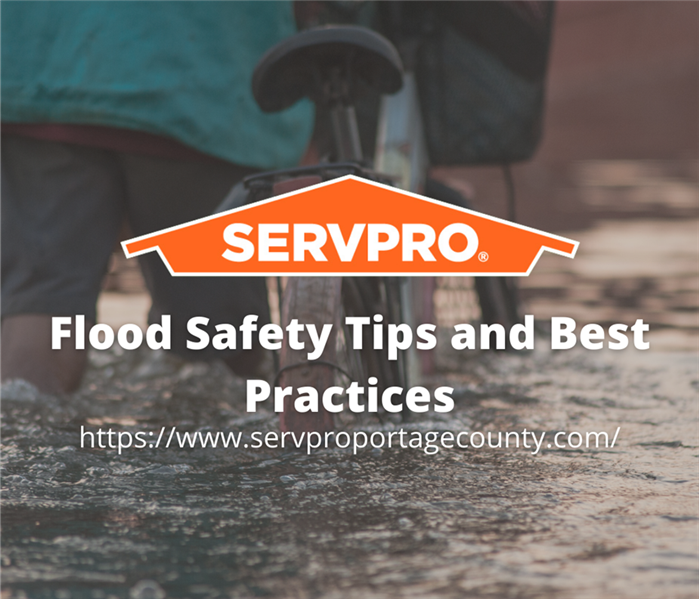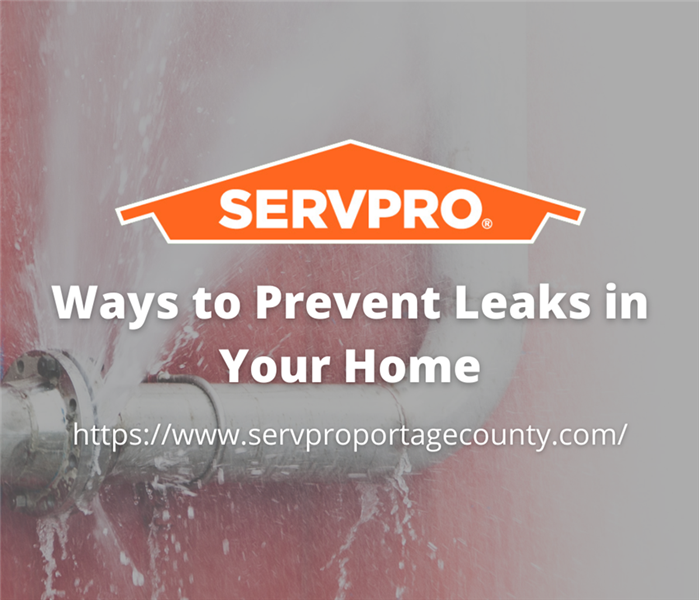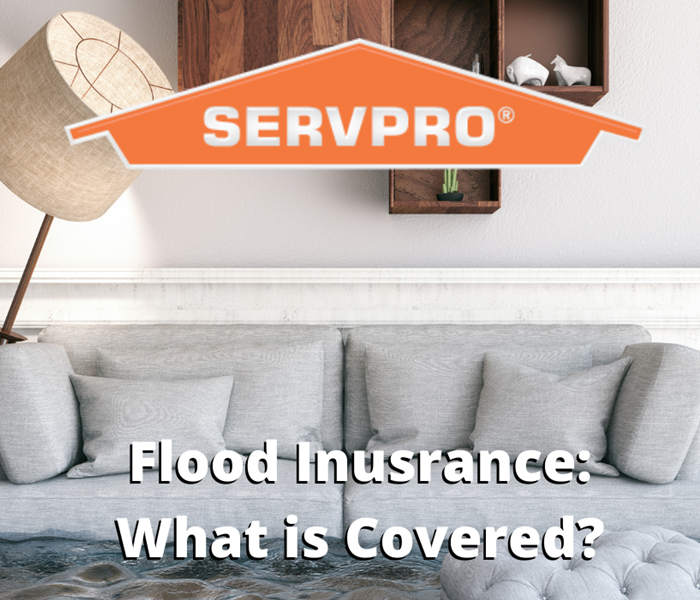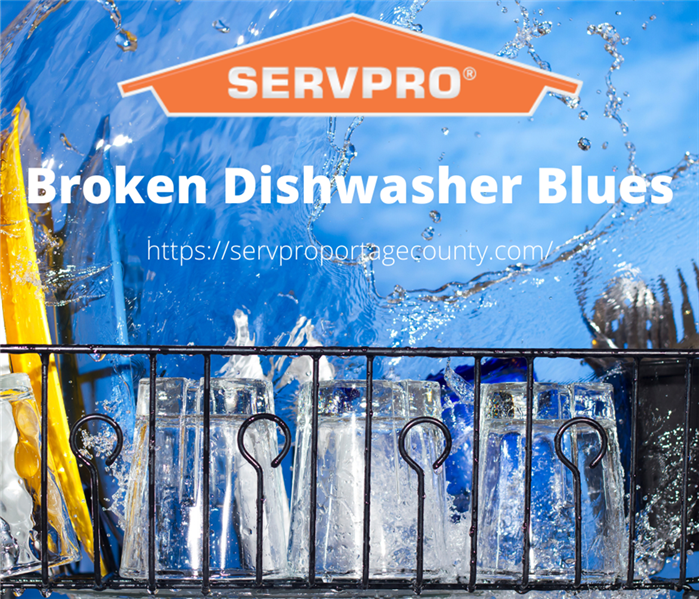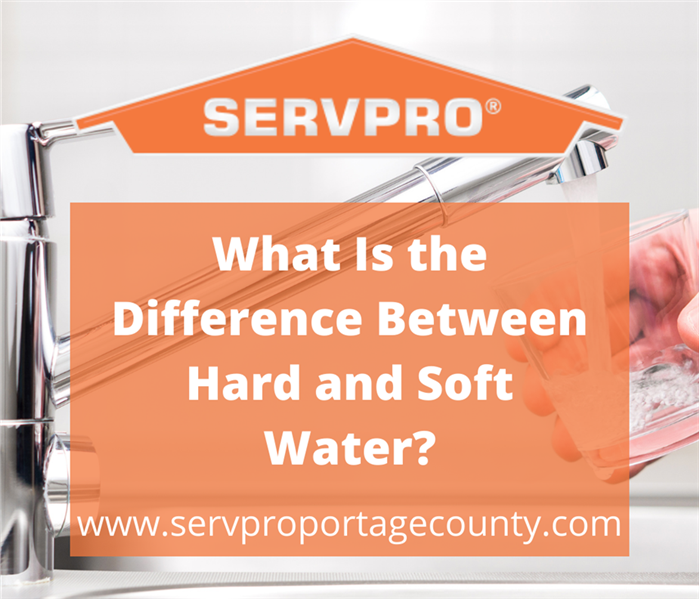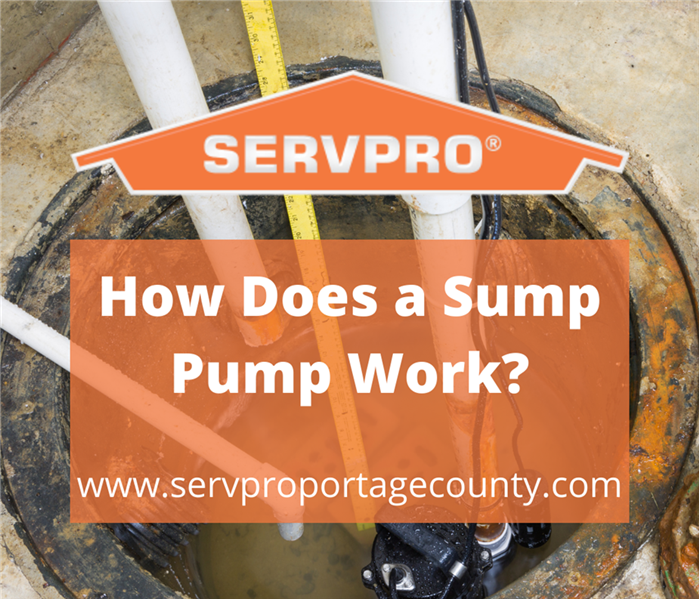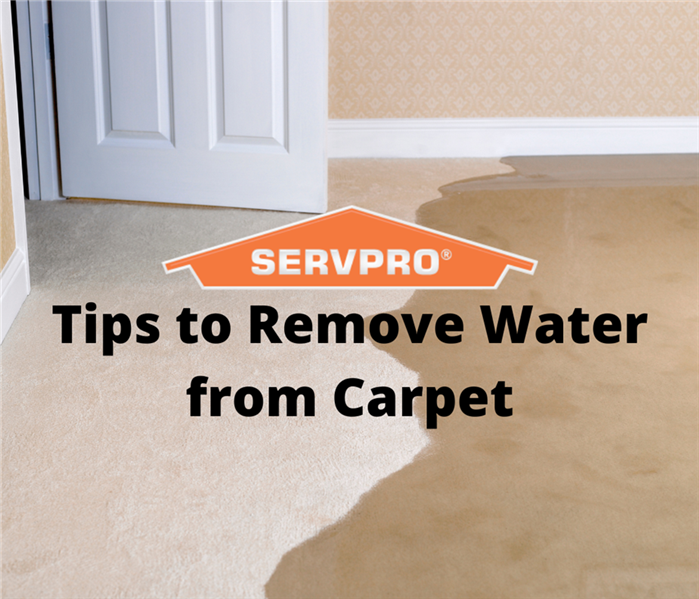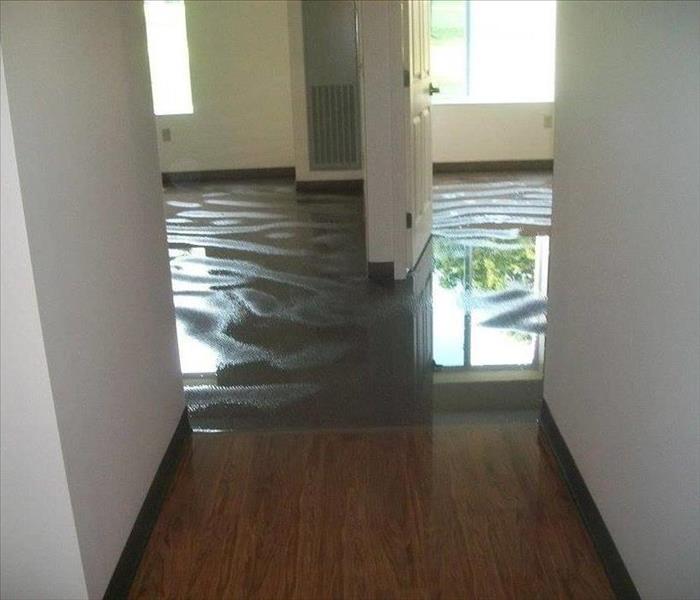Recent Water Damage Posts
How to Prevent a Flood From Happening in Your Home
7/26/2022 (Permalink)
Nobody wants their home to flood. But there may be flooding circumstances that we will have to look out for. There are some great ways to make sure that this never happens, and if there is a flood warning, you, your family, and your house remain untouched.
Raising Your Home’s Flood Level
Raising your home's flood level is a great exterior change that will have a lasting impact. The best way to achieve this is by installing stilts or piers on the outside of your home is a great way to lift it off of the ground if a flood were to ever occur.
Mulch and Siding Tip
Space between your mulch and your siding on your home is a great way to prevent any flood damage as well. If the mulch on the outside gets wet, it can rot and deteriorate your home's siding, leading to more issues of flooding and an unstable house.
Install a Sump Pump or Check It Frequently
If you do not have a sump pump, the time is now. These are great for pumping any excess water out that may escalate into a flooded home.
Raise Electrical Outlets
This may not be a tip in preventing a flood, but it is a great tip for if a flood ever happens. Making sure that your outlets are raised and are far off the ground or past the flood line is a great way to ensure your and your family’s safety and any electrocution risks.
Check Valves
Check valves are important to make sure that there is no chance of having a flooded system. This will also help to prevent flooding based on knowing that there is a lessened chance of a flooded system.
It is important to check your home’s flood-resistant levels and to make sure that you are ahead of a future flood disaster. SERVPRO is here for you and will be here if anything happens, 24/7.
Flood Safety Tips and Best Practices
7/6/2022 (Permalink)
Flood warnings are not as common as storms such as a thunderstorm, but there is always a possibility of one happening in your area. So, where should you go during one, and what are some tips for evacuation and traveling?
Do Not Walk Through Water
If you are evacuating during a flood, it is important to not walk through any flowing water if you are able to. This is important because if the water is flowing at a rapid pace, there is a good chance that you or somebody you are evacuating with could drown.
Don’t Drive Through Roads With Flooding
If you attempt to drive through water, your car is always at a chance of being swept away. If your car is stranded in water, never get out of your car. If the water is rising and you cannot move your car, get out of the car through the window and sit on the roof of your car.
Staying Inside
If you are advised to stay inside during this warning, make sure to have a radio or television on with the news on. This is the best way to find out what you or your family should be doing.
It is important to always be as safe as possible during floods, and if you are advised to leave, never drive or walk through flowing water, and make sure that you are being vigilant and watching or listening to updates on your situation via the news or a radio, or your phone if you don’t have access.
Ways to Prevent Leaks in Your Home
5/24/2022 (Permalink)
Leaks can span from a pipe bursting to a leaky roof that is extremely noticeable when there are high amounts of rainfall. There are ways to prevent any types of leaks in your home, and these will be beneficial in preventing any water damage.
Inspect Drains and Gutters
Making sure that your drains and gutters are not damaged or water is not trapped in them is a great way to prevent any leaking on the outside or inside of your home. One tiny leak can lead to a bigger problem, and preventing this from happening is what you should aim for.
Damaged Sump Pump
Making sure that you or your provider are checking your sump pump regularly is a great way to prevent any water damage. Catching these issues early and keeping up with any issues you may have is a great strategy for preventing further damage.
Rain Runoff
Making sure that your rain runoff setup is away from your house is a great prevention technique in making sure that the water does not pool around your home or seep into cracks and holes that could lead to bigger problems.
Water Main Shutoff Valve
Making sure that you have steps to prevent any water damage before it happens is the goal. Having a water main shutoff valve is great for keeping track of your water and seeing when there is too much, or when your home could be at potential risk of flooding or a leak.
There are many ways to prevent leaks to your home, and keeping up with your home and catching these issues before escalation is a great way to prevent future water damage. SERVPRO is here when you need us, 24/7.
What is a Boil Alert?
5/2/2022 (Permalink)
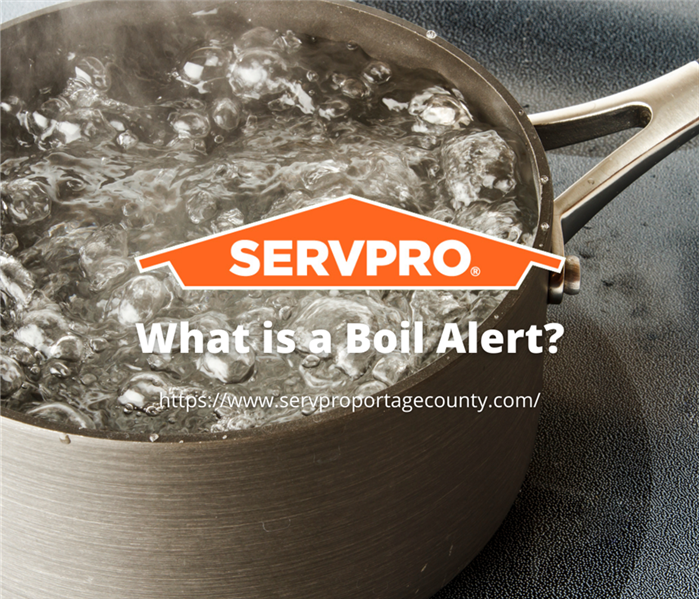 What is a Boil Alert?
What is a Boil Alert?
Boil alerts are not extremely common, but there is always a chance that these could happen wherever you are. Knowing what to do and understanding what this means will be beneficial to you and your family in the long run.
Boil Alerts or Boil Water Advisories are known as circumstances where local health officials will advise you to use bottled water or to boil water from your sink. This is because boil advisories are due to germs being found in your water or a potential threat for germs being found in your water. What is some common advice for these occurrences?
Using Bottled or Boiled Water
This will be suggested for drinking and for cooking and preparing food. Even if your tap water is filtered, you should still boil it for extra caution.
Handwashing
You are usually still able to wash your hands with soap and water. Just make sure you are doing it for the recommended 20 seconds.
Showering or Bathing
This is also still okay, but be cautious and do not swallow the water that you are showering or bathing in.
Brushing Your Teeth
When you are brushing your teeth, it will be advised to use bottled or boiled water.
Dishes
Rather than using and washing dishware, it will be advised to use disposable plates, cups, and utensils if possible.
These are the main occurrences that you should be aware of if you are ever in a Boil Alert or Boil Water Advisory.
Flood Insurance: What is Covered
1/18/2022 (Permalink)
Have you ever been told that you should purchase flood insurance? If you live in a flood-prone area, the chances are you probably have, and you probably have questions. We’re here to answer them for you!
What Does Flood Insurance Cover?
There are two main types of flood insurance-- building coverage and contents coverage. Building coverage covers your electrical and plumbing systems, furnace, water heater, permanent appliances, permanent flooring, cabinets, walls, and most other things that are physically a part of the building you are insuring.
Contents coverage covers personal belongings, such as furniture, clothing, curtains, removable appliances (such as washers, dryers, or microwaves), non-permanent flooring, and your valuables.
What DOESN’T Flood Insurance Cover?
Luckily, flood insurance will cover most of your property and belongings, but there are some things that it won’t cover. For example, most flood insurance will not cover vehicles, temporary housing while your home is restored, valuables such as currency or precious metals, or personal property that you keep in your basement.
Even when it comes to the items that are generally covered by flood insurance, your coverage may ultimately depend on the cause of the flood. For example, a backed-up sewer will not be covered by flood insurance unless the backup was a direct result of the flood.
Broken Dishwasher Blues: Cleaning After An Appliance Causes Water Damage
1/3/2022 (Permalink)
One of our primary focuses here at SERVPRO is storm damage-- but there are a lot of other things that can cause damage to your property. For example, have you ever thought about what you should do if your dishwasher causes a flood?
The first thing you should do as soon as the flood has occurred is to shut off the circuit breaker and mop up the water in your kitchen. It’s important that you shut off the circuit breaker rather than attempting to unplug your dishwasher-- unplugging any electrical appliances during a flood can be extremely dangerous.
Once this is done, it’s time to open your dishwasher and inspect the damage. Carefully remove any dishes that may have been in the dishwasher and keep an eye out for anything that may have broken. Also, check to see if any parts of the dishwasher could have been blocked up, causing the flood.
Depending on your dishwasher’s warranty, some things, such as hoses, can be easily repaired or replaced on your own. However, if your dishwasher is still under warranty or the problem appears to be a particularly difficult fix, it’s best to hire a professional. Depending on the extent of the damage to your kitchen, you may need to hire a water damage professional, like SERVPRO, to begin the restoration process.
What Is the Difference Between Hard and Soft Water?
9/6/2021 (Permalink)
Water makes a big difference to your home and lifestyle – whether you are in a hard or soft water area is important to know.
What is the difference? Unless you only drink distilled water, all water has traces of other minerals in it depending on where it has been sourced from.
Hard water simply has higher and more noticeable quantities of dissolved minerals in it, mainly calcium from areas with lots of limestone in the ground. Soft water has low levels of other minerals and is closer to being just H2O.
(Do not confuse hard water with heavy water….that is a slightly different molecular makeup of water used in nuclear reactors and not in your home.)
Rainfall is naturally soft water, but as it soaks into the ground it picks up minerals from the rocks and earth before finding its way into our water supplies.
There is nothing inherently wrong with either type – both are fine to drink. Hard water can even be sought after for the extra mineral content as good for bones, and some say they prefer the flavor. Soft water can have a salty edge, especially if it is soft because it has been run through a household softener that uses sodium.
But hard water does have its drawbacks – the minerals in it reduce the effectiveness of soaps and detergents, creating fewer bubbles and leaving a film or soap scum behind, or dulling laundry.
And when hard water is heated in appliances like washing machines, water heaters, and kettles, the minerals come out of the solution and solidify as white chalky flakes. Again, these are harmless to humans – but not your appliances. The residue – effectively small pieces of limestone – will make your equipment less energy-efficient and shorten its useful life as the limescale builds up over time.
How Does a Sump Pump Work?
9/6/2021 (Permalink)
Has your home ever flooded? Sump pumps are what help prevent this from happening to your home. They help to keep out any groundwater intrusions from coming through and causing damage to your home.
What do sump pumps do?
The main purpose of a sump pump is to send water away from your home to a place where it won’t cause any problems. It collects water coming into a building from rain, melting snow, etc, and leads it out. Without a sump pump, your home may flood, or build up high levels of water and moisture. These can be damaging to your home and the things within it.
How exactly does it work?
A sump pump is typically located on the bottom floor of a home to prevent flooding. Its purpose is to collect water and dispose of it, but how exactly does it do that? All of the water collected from the sump pump is drained into pits beneath it. The water is then pumped from those pits away from the home’s foundation, whether it's to a drain or elsewhere. A sump pump isn’t always running because the amount it does depends on the amount of water and moisture your home has that needs to be drained.
Next time it rains just know that your sump pump is doing its job to protect your home. Here at SERVPRO of Portage County, we want to ensure you and your home's safety.
Tips to Remove Water from Carpets
7/8/2021 (Permalink)
Water, the invisible stalker of carpets and drywall! When your home or business is faced with water damage or even general moisture, you may not see it, but it will cause damage and possibly even danger. One of the least fun places to have water sitting is in your carpets, not only will it smell but it will eventually create mold and other harmful bacteria. So how exactly do you make sure that water is properly removed from carpets?
There are a few different options and steps to take when it comes to getting water out of the carpet.
Good ole fashion towel dry
A good place to start is soaking up the water with large towels. This will be an option to at least get the process started and hopefully get a good amount out. Of course, some situations won’t allow for an immediate towel dry.
Wet Dry Vac
If you do not have your own wet-dry vacuum, you may be able to rent one. Using one of these will be a good method to get the water that you may not see or feel, the power of the vacuum will suck up that water at the base (even under) your carpet.
Dry it out
Another easy method to help the process is to use industrial size fans and dehumidifiers to air dry the rest of the water in the room. This is helpful, but will usually be towards the end of the process and paired with other methods.
These are just a few simple DIY methods to remove water from your carpets. It is crucial to get the area dry and cleaned as soon as possible. This will help to preserve your carpets, but also protect you and your loved ones from the build-up of mold and bacteria. If you find that your floors are far too saturated to handle on your own, give SERVPRO a call, our disaster recovery team will be able to help you get your property dry and back to normal in no time!
Managing Humidity in Portage County
5/4/2021 (Permalink)
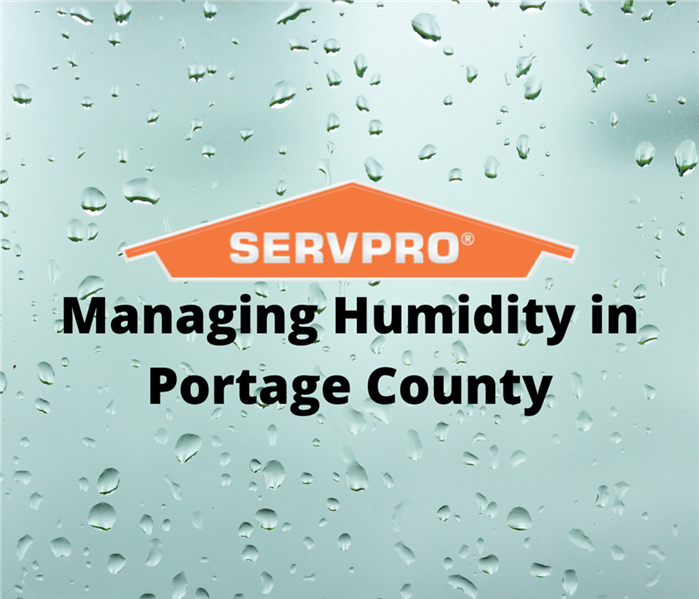 Make sure your home is prevented from humidity-caused water damage.
Make sure your home is prevented from humidity-caused water damage.
Humidity is the concentration of water vapor that is present in the air, and the level of water the air can hold. We all know those “humid” summer days that just feel hot and sticky. While this is most definitely uncomfortable, what is worse is when humidity enters your home or business. While small amounts of humidity may not be anything to worry about, it is a different story when your basement remains humid. The good news is that warm damp basements can be managed and even avoided.
- One very simple and common step to take in order to avoid humidity in your home is placing a humidifier in the most concentrated area. The silica gel beads that are used will help to absorb the water vapor in the air, and therefore prevent mold and mildew build-up.
- Another simple, and even free option is to clean! If cleaning is already on your “To-Do list”, then this should not be too much of a hassle. When you keep the area clean and clear, there are fewer spots for mold and mildew to grow. Plus, there is the added benefit of enjoying a clean and clutter-free environment!
- As you do your cleaning and usual chores, take a little walk around the perimeter of the basement. If you notice any gaps or holes, you can seal those up for an extra barrier against moisture.
- Don’t just stick to the basement! Check your roof, gutter, and other drainage areas, if these spots are backed up, they may cause more issues for down below!
By taking just a few simple measures, you can avoid having a build-up of mold, mildew, and other bacteria in your home or business. Like most building repairs and tweaks, this may seem like a minor issue that could actually lead to a lot of trouble later on. If your basement is past the point of managing, and you need a good cleaning, you may consider a professional cleaning service to rid the area of any bacteria. For help getting your basement clean and clear, give us a call and ask about our unique 3 C’s when it comes to cleaning!
Mold Growth from Water Damage: Dangerous Types to Look For
1/4/2021 (Permalink)
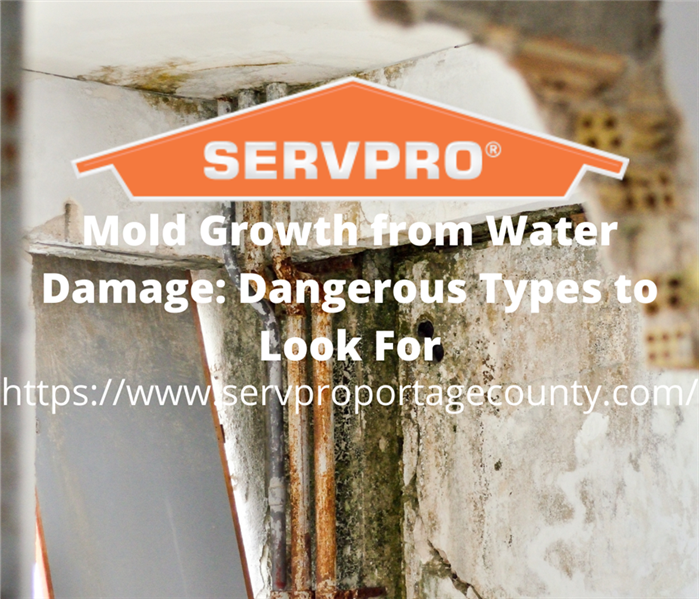 Prevent water damage in your Portage County home and business.
Prevent water damage in your Portage County home and business.
Discovering you have mold in your home can be scary, but it is important to know what exactly you are dealing with. Mold is a term for many types of fungi that are unwanted, unappealing patches of black, brown, yellow, pink, green, smelly, or fuzzy growths. There are countless varieties found both indoors and outdoors and almost always hold a negative connotation, but without mold, we wouldn’t have penicillin or bleu cheese! When it comes to your home, the negative connotation holds true and should be taken care of by a professional if found. Active mold needs water to grow and thrive, so having water damage in the home is a perfect breeding ground.
Harmful molds can be any of the following classifications:
Common Molds Found at Home:
- Acremonium - Toxigenic mold type that evolves in appearance over time. It starts out a small moist mold and turns into a fine powdery substance. Typically grows in areas near humidifiers, cooling coils, and drain pans.
- Alternaria - The most common form of allergenic mold in the world. It’s a velvet-textured mold with dark green or brown hairs. It typically grows wherever dampness occurs.
- Chaetomium - Toxigenic mold commonly found in water-damaged homes, most commonly in a damp or leaking roof, basement, or sink. It has a cotton-like texture and usually changes colors from white to grey to brown, and eventually black.
- Penicillin - Allergenic mold that is easily recognizable with blue or green color and velvety texture. Often found in water-damaged homes and buildings. It is found in materials such as carpets, wallpapers, ducting, and even mattresses.
- Stachybotrys - Toxigenic mold also known as “black mold”, also can cause health effects. It is dark green or black with a slimy texture. Stachybotrys thrive in damp, wet areas with high humidity levels that maintain these environmental conditions for weeks.
These are just a few of the most common mold types, but there are many more that can be found and can be harmful to you and your family. Since mold thrives in damp environments, a home with water damage becomes the perfect breeding ground. Mold can be dangerous and should be handled by professionals. If you have mold or suspect you might; call SERVPRO so you can rest easy knowing the problem will be handled quickly and safely.
Homeowner Tips for Living in a Floodplain
12/2/2020 (Permalink)
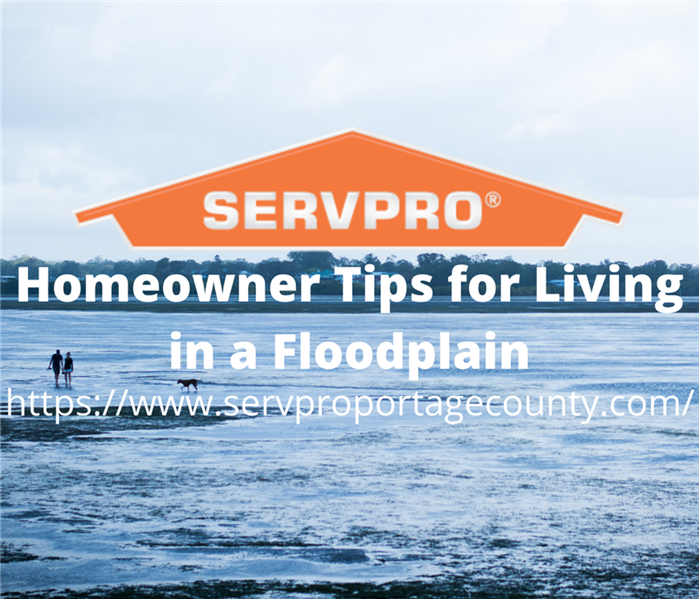 Make sure you are prepared for floodplain living in all seasons.
Make sure you are prepared for floodplain living in all seasons.
Flooding is becoming more frequent and severe due to climate change. Heavy downpours, rising sea levels, and asphalt everywhere are all factors in increased flooding in recent years. If you live in a floodplain you are even more at risk. Flood plains are areas the National Flood Insurance Program considers at high risk for flooding, otherwise known as Special Flood Hazard Areas. The NFIP defines these as areas with a 1 percent annual chance of flooding, which is equivalent to a 26 percent chance over the life of a 30-year mortgage.
When living in a floodplain it is required that you hold flood insurance, this is a good thing to have if a flood does occur, the cost of damages can be substantial. Flood damage can range from somewhat manageable, like a couple of inches in the basement, to full-blown home destruction. There are precautions you can take as a homeowner to minimize flood damages.
- Elevate the living areas to above “base flood elevation.” You can find your specific level from FEMA.
- Build or retrofit your house with flood-resistant materials.
- Elevate your furnace, water heater, air conditioner, and electrical panel above the flood level.
- Turn off the electricity if your home is about to flood
- Change your landscaping - Add porous surfaces, dig trenches, and use absorbent mulch.
Learning how to prevent major flood damage can go a long way in easing the stress of living in a flood plain. Some tasks require the help of a professional. SERVPRO is here to help you with any storm prevention techniques, give them a call today!
Moisture in the Air Could Lead to Mold
9/20/2020 (Permalink)
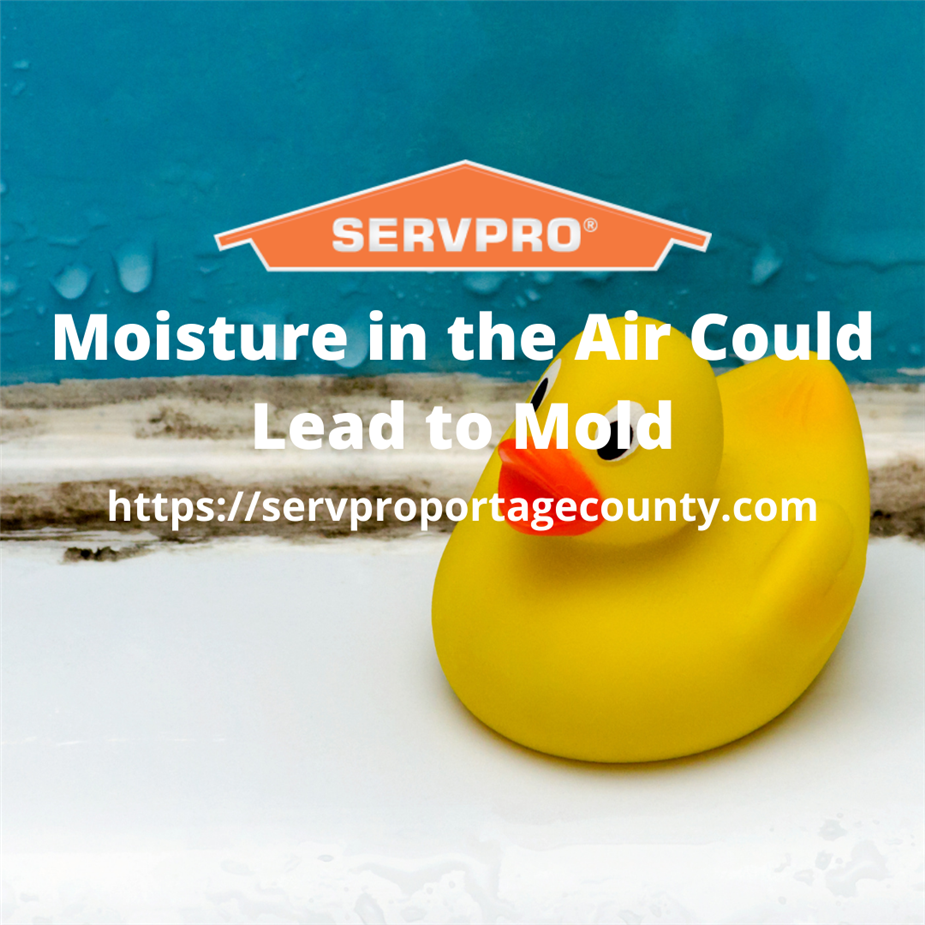 Take care to make sure that too much moisture in the air doesn't cause damage to your home.
Take care to make sure that too much moisture in the air doesn't cause damage to your home.
As if we didn’t already have enough to worry about, Covid has placed an extreme weight on our need to understand how tiny particles in the air can be directly harmful to our health. The air all around us is literally exploding with the seeds of life, most of which would never cause us any more than the hassle of a sneeze. But as the summer months fade, and the rain picks back up, moisture and breaking down plant matter create the perfect environment for mold and fungus spores.
Research has proven that simple steps to decrease the level of moisture in the home, in order to decrease the spread of molds, has tremendous health benefits. Many of us are unaware of the myriad of health effects that allowing molds and fungi to gain a hold in our homes can cause. Young children and the elderly are especially at risk.
As if that weren’t enough, untreated moisture issues in the home can attract cockroaches, rodents, and dust mites. Moisture laden building materials can also, when exposed to moisture, exhale volatile organic compounds that can cause health problems as well.
So, what can we do? It is not possible to eliminate all traces of mold and fungus from the air: there are far too many and are carried even by our pets and ourselves. So it’s critical to treat the moisture issue to keep the spores from settling in and becoming harmful. SERVPRO of Portage County’s highly trained mold removal and remediation specialists are on call to make this added problem a distant memory, so we can get back to living safely and happily at home!
Water Damage Comes From More Than Just Weather
9/1/2020 (Permalink)
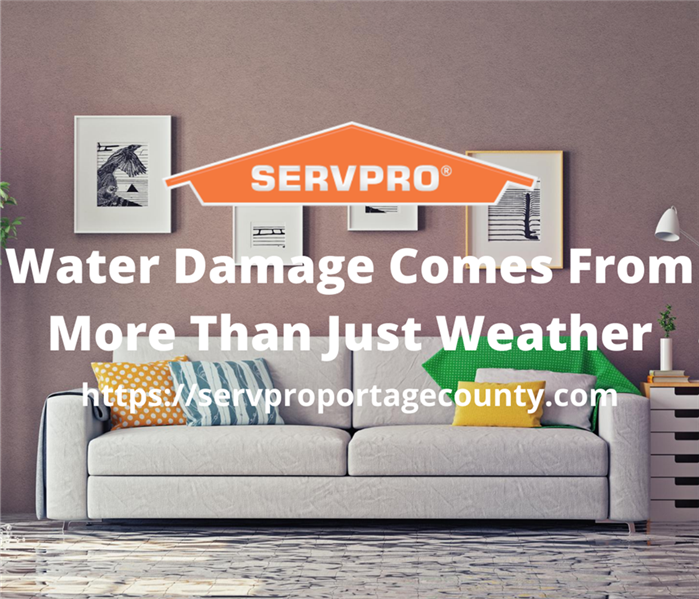 Don't be surprised by in-home disasters causing water damage.
Don't be surprised by in-home disasters causing water damage.
Many home and business owners know that extreme weather can cause damage to their properties. But sometimes, people don’t realize that water damage isn’t just a threat when there are heavy rains falling. Old and faulty plumbing can cause major issues for a property. In fact, plumbing is a much more common cause of water damage for homeowners, especially from devices like water heaters, ice machines, dishwashers, washing machines, and toilets.
Having your plumbing system regularly maintained is a big factor in keeping your home or business free from water damage. One of the most troublesome factors of plumbing water damage is that it can often go unnoticed for long periods of time, leading to bigger problems with the integrity of your structure as well as dangerous mold damage.
Taking the time to regularly service the devices connected to your plumbing could save you much strife in the long run. Checking your sump pump, for instance, is an easy way to ensure that you don’t experience flooding your basement. Additionally, homeowners with a water heater that is more than 15 years old are at a high risk to experience water damage in the property due to faulty equipment.
Other than performing regular maintenance, there are some emergency water alert systems that a home or business owner can invest in to make sure they do not experience water damage. Some systems will alert people that water is running in a place or fashion that it is not supposed to, and other systems will automatically shut off the water if and when leaks or issues are detected. These systems could be very helpful in the event of a disaster in your home.
If you ever do experience water damage at your property, it’s important to remember that a quick response is vital to mitigate the damages. SERVPRO of Portage County will be there any time, day or night to help return your space to normal. We are on your side, faster to any disaster.
Unnoticed Water in Your Home Could Lead to Damage and Mold
7/20/2020 (Permalink)
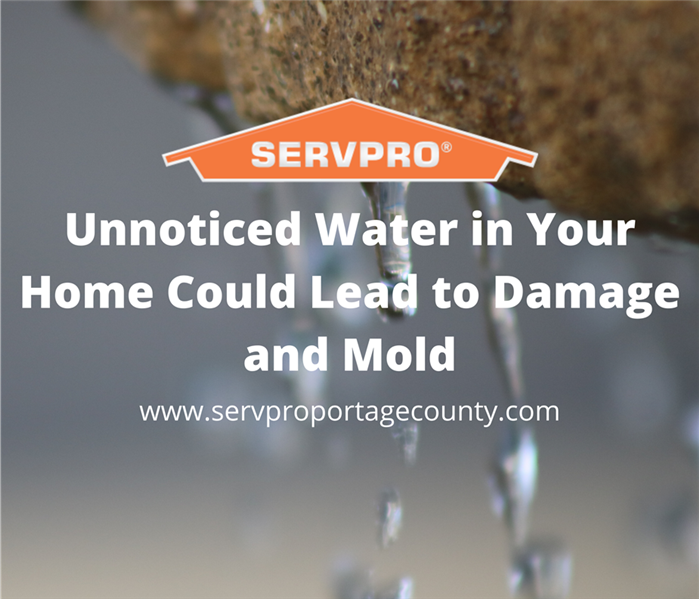 Stay alert for signs of water damage in your home.
Stay alert for signs of water damage in your home.
Water is our main life-force as humans. We are mostly composed of it and we need to drink it to survive. We use it to clean ourselves and our homes and remove our waste – the advent of bringing running water into our homes truly changed the way we exist within the world. But water can also cause problems. This powerful force can eat away at things we love, damage structures, and cause a silent issue: mold and mildew.
Sometimes, when you have water damage in your home, it is easily apparent – situations like a flooded basement or a puddle on the floor next to the sink or the toilet. Of course, when these things happen you know that a quick response is important and cleaning thoroughly after the necessary repairs have been made is crucial. Other times, however, water damage can happen without you having any idea.
There are a lot of places around your home where water could easily be collecting without you noticing it. On the outside of your home, window and door frames, siding, and chimneys are all common places where water can enter and cause damage. Inside, anywhere there are pipes could become an issue. Most commonly, you will want to keep your eye on the area under your dishwasher, around your toilets, under sinks, and behind washing machines. Air conditioning units can also cause problems because of condensation. If you have a window unit, make sure you are looking under and around it, or if you have an HVAC unit, try to keep it regularly maintained and serviced.
If water is collecting in the walls of your home, however, it can be hard to tell unless you rip out the drywall and take a look. It’s important to keep an eye out for signs that something might be wrong. Musty odors, stains or discoloration, peeling paint or wallpaper, and warping walls, ceilings, or floors are all signs that there is an underlying issue that needs to be handled. Perhaps the most obvious sign, however, is visible mold. If you can see mold in your home, there is an issue that needs to be addressed immediately.
If you have water damage in your home, a quick response is vital to effectively address the situation. SERVPRO of Portage County has a team of highly-trained technicians who can help restore your home to perfect condition. From water damage repair to mold remediation, we can handle whatever problems you’re having. Call us at (330) 677-4483 and let us help make it "Like it never even happened."
Prepared for Portage County Storm Season?
5/24/2020 (Permalink)
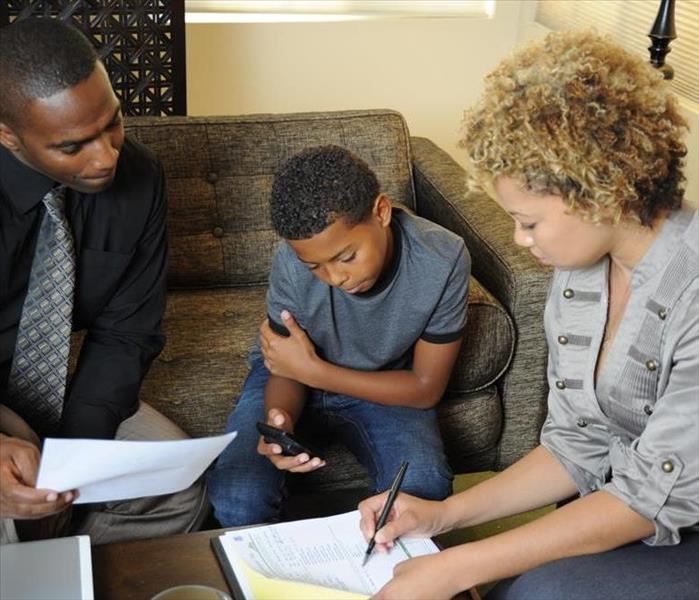 Get your family prepared for anything with a Family Emergency Plan.
Get your family prepared for anything with a Family Emergency Plan.
We never think it will happen to us but disaster could strike at any time. May is the beginning of storm season in Portage County. Are you prepared? Knowing what to do in the event of an emergency could make a huge difference when it comes to keeping your family safe. That's why you should create a Family Emergency Preparedness Plan so you can take action quickly in case anything goes wrong.
There are several great sources for creating a Family Emergency Preparedness Plan. Review a few different plans and then get started gathering items for your Family Emergency Kit. Start with the items which may be medically necessary and prioritize the remaining list according to need. Listing the items in priority of need will help to keep your Emergency Kit budget-friendly as you could easily go overboard when getting prepared. Using items currently in the home is also a good way to cut costs.
Resources for creating your family emergency plan:
Department of Homeland Safety: https://www.ready.gov/plan
National Storm Center: https://www.stormdamagecenter.org/
FEMA: https://www.fema.gov/media-library-data/1440449346150-1ff18127345615d8b7e1effb4752b668/Family_Comm_Plan_508_20150820.pdf
American Red Cross: https://www.redcross.org/content/dam/redcross/atg/PDF_s/Preparedness___Disaster_Recovery/General_Preparedness___Recovery/Home/ARC_Family_Disaster_Plan_Template_r083012.pdf
2020 has been an unprecedented year, Portage County along with the rest of our Nation is dealing with the Coronavirus/COVID-19. We don’t expect the unexpected, but it happens without warning. Developing a family emergency plan is a great way to bring the family together - work together on the plan, and check your needed items off the list. This will help inform the children and remove some of the fear of the unknown. Through practice, your whole family should become confident in your plans.
SERVPRO of Portage County knows that storm, and flood damage can have a huge effect on your family, home, or business. In the face of such a horrible event, we want you to know that SERVPRO is here to help with 24-hour emergency services because we know storms happen at anytime or any-day. SERVPRO of Portage County has highly trained water restoration technicians and is a trusted leader in the water restoration industry.
When a storm hits your Kent home, you need the company with storm damage experience and expertise.
Six Ways to Defend Against Ice Dams in Winter
1/4/2020 (Permalink)
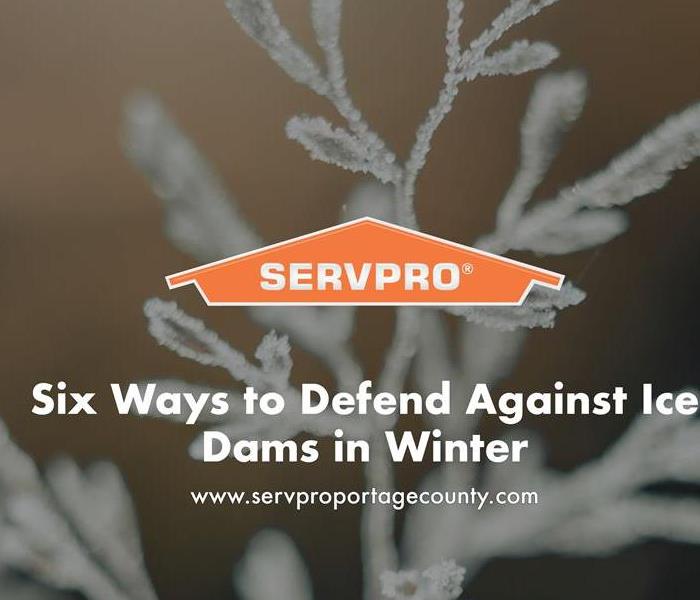 We know how devastating a water disaster can be, but we are here to help!
We know how devastating a water disaster can be, but we are here to help!
Property owners in Portage County can have water damage stemming from the roof. This is a bigger threat after winter storms than any other. The problem starts with ice dams: the roof melts snow, water flows down to the colder eaves and refreezes there.
This cycle repeats and ice accumulates in layers, but also pushes under shingles. It eventually leaks into walls, ceiling and even insulation. This can be heavy enough to pull gutters off buildings or detach.
Here are ways to defend against ice dams:
- Survey your attic to finds openings: Insulate or caulk these openings in chimneys, plumbing pipes, electrical conduits, fan outlets, and junction boxes.
- Improve the attic entrances: Entrances are the biggest offenders that channel heat into attics.
- Increase insulation. Attics should ideally have at least a foot of insulation between living spaces and attic interiors.
- Inspect ventilation outlets: Heat that enters the attic needs an easy escape route make sure that they are not blocked and are working properly.
- Remove heavy snow from roofs: Snow insulates the attic which increases the attic temperature.
- Call a professional. If you suspect ice dams are a problem for your house, call a professional like SERVPRO.
We know how devastating a water disaster can be, but we are here to help! Call SERVPRO of Portage County (330) 677-4483 to help get your home restored efficiently.
Avoid Bursted Pipes in The Winter Months
12/2/2019 (Permalink)
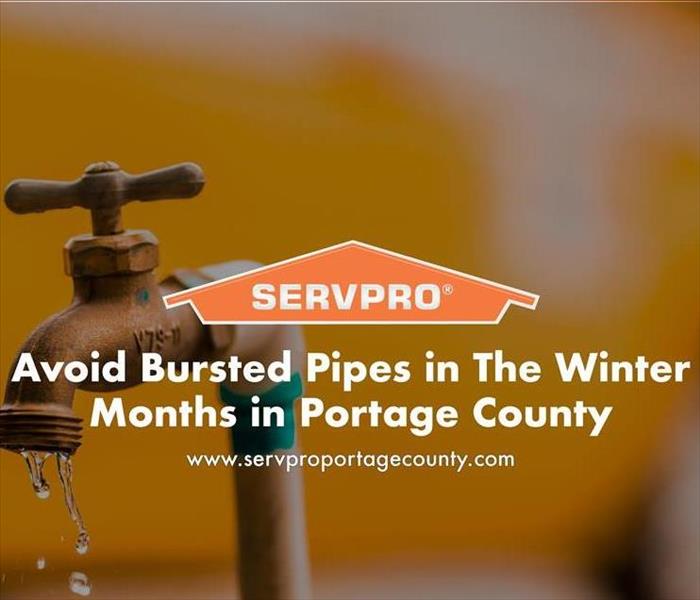 We know how devastating water damage can be, but we are here to help! Call SERVPRO of Portage County (330) 677-4483 to help get your home restored.
We know how devastating water damage can be, but we are here to help! Call SERVPRO of Portage County (330) 677-4483 to help get your home restored.
Winter is the time for frozen pipes and burst pipes. Frozen pipes can mean big problems for your home. As water freezes, it expands and can exert up to 2,000 pounds of pressure per square inch! This pressure can cause pipes to burst and water to flow into your home leaving tons of disaster problems for your home in Portage County.
In order to prevent frozen pipes in those areas, follow these tips:
- Drain water from hoses, water sprinklers, and other outdoor lines, before it is too late.
- On cold days, open cabinet doors to allow warm air to flow around pipes.
- Turn on the water taps slightly to allow a slow drip to run through the faucets.
- Make sure that there is insulation present in areas around pipes that are susceptible to cold weather.
- If you are leaving for vacation, don’t set the temperature any lower than 55°F.
Putting these tips into practice will significantly reduce your chances of having a pipe freeze in your home, and thereby, avoid the larger and much more costly and inconvenient problem of a pipe burst.
We know how devastating water damage can be, but we are here to help! Call SERVPRO of Portage County (330) 677-4483 to help get your home restored efficiently.
Water Damage Can Cause Damage Quickly, Act Quick!
9/26/2019 (Permalink)
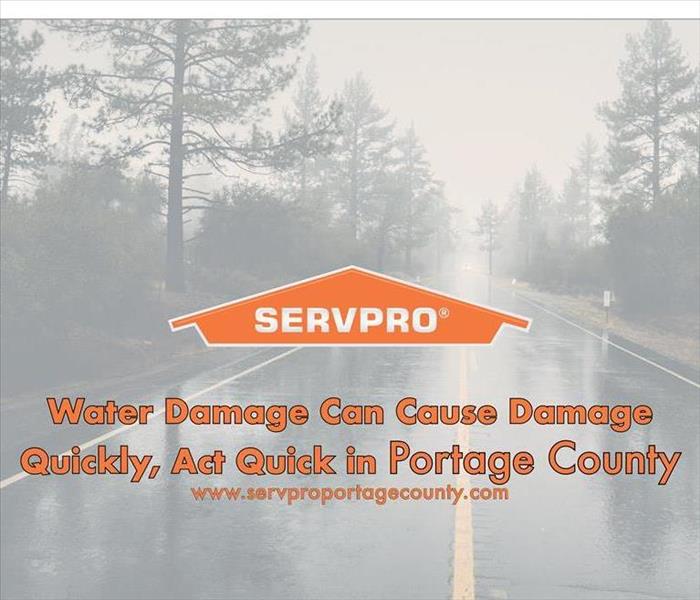 Floods, rainstorms and ice storms can become massive water damage threats to homes in Portage County.
Floods, rainstorms and ice storms can become massive water damage threats to homes in Portage County.
Floods, rainstorms and ice storms can become massive water damage threats to homes in Portage County. Facilities plagued with such water problems this season must take quick action
Water damage can mean much more to a house than just wet carpets. There are other common problems houses face when water wreaks havoc on property, such as indoor air quality problems. Mold and mildew grow rapidly in damp, humid environments, leaving behind an unpleasant smell that permeates floors.
Damage to the building’s structure and foundation also can be an issue. When water sits inside a building for a period of time, the walls, ceilings and floors absorb the water. Total reconstruction of the building often becomes the only option.
To minimize water damage, there are two critical steps that need to be taken:
- Act fast to assess the situation
- Control the environment within the building.
Act Fast and Call an Expert
The absolute first step to take is fast action. The longer the water flows the greater the recovery problem becomes.
In a typical scenario, a team of water damage recovery professionals, such as SERVPRO of Portage County, is dispatched to the site to perform a thorough inspection and fully determine the extent of the damage. A disaster reclamation partner also will develop an intense restoration plan and determine which items are worth restoring and which are better replaced.
Controlling the Interior Environment
The other key in limiting water damage is to quickly control three conditions: relative humidity, temperature and air circulation.
The most effective way to control these conditions is to employ professional disaster drying that combines air movers with desiccant dehumidifiers.
Disaster drying often eliminates the need to rip out and replace walls, carpet, floor covering, hardwood floors and the building structure. On top of that, you preclude the odors and staining caused by mold and mildew. These problems can come back to haunt you weeks later in a superficially dried building.
We know how devastating water damage can be, but we are here to help! Call SERVPRO of Portage County (330) 677-4483 to help get your home restored efficiently.
SERVPRO of Northern Summit County uses structure materials with thermal imaging
8/28/2019 (Permalink)
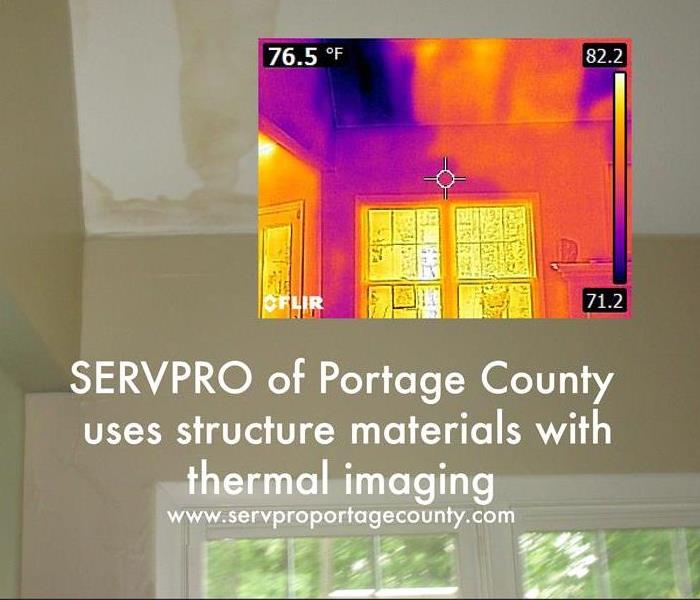 Thermal imaging one service at SERVPRO of Portage County and is used to utilizes water damage in your home.
Thermal imaging one service at SERVPRO of Portage County and is used to utilizes water damage in your home.
SERVPRO of Portage County uses structure materials with thermal imaging such as structure materials with thermal imaging and standard camera. Red, yellow orange indicated dry and blues and purples indicate elevated moisture.
Using thermal imagers to detect moisture intrusion is a relatively new practice in water damage mitigation. Thermal imaging has be used successfully to detect water intrusion in interior walls following roof leaks, foundation failure, chimney leaks, etc. It can find things that the naked eye doesn’t always see.SERVPRO of Portage County has this powerful equipment to help get your water damage taken care of.
There are a number of areas where moisture can accumulate that are frequently overlooked in typical inspections. Thermal imaging technology can help reduce the cost to repairs by minimizing damage to the property to find the core source of water intrusion.
Thermal imaging one service at SERVPRO of Portage County and is used to utilizes water damage in your home. Contact us today to schedule a site inspection(330) 677-4483
Ways You Can Prevent Water Damage in Portage County
7/12/2019 (Permalink)
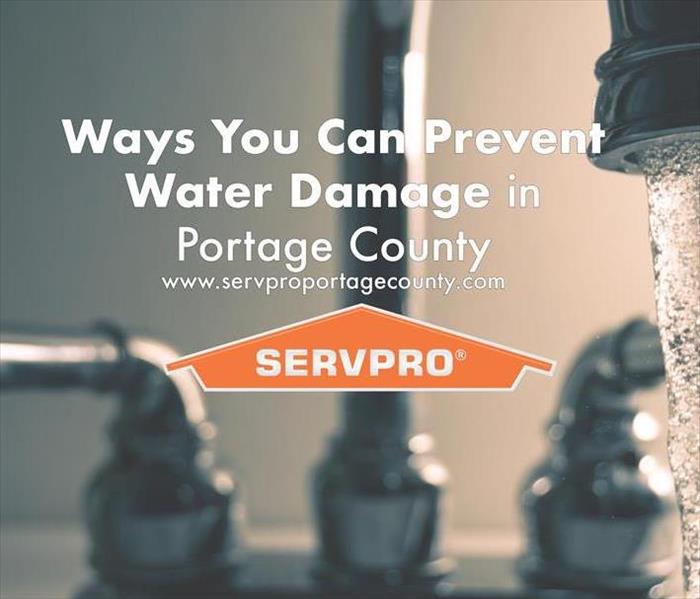 If you need help with any water damage clean-up, don’t hesitate to call our well-trained professionals at SERVPRO of Portage County.
If you need help with any water damage clean-up, don’t hesitate to call our well-trained professionals at SERVPRO of Portage County.
When you own a home, maintaining can seem tiresome. That maintenance is one of the best ways to prevent water damage. Consider it a way to avoid a more costly outcome as water damage ranks among the highest for cost.
What can be done to prevent water damage? Here’s a list to add for maintenance for a start:
- Proper Drainage: This step is vital. Poor drainage can lead to many issues such as cracks in your foundation, uneven settling, and allowing ways for water to seep into your home. Gutters and downspouts are included in this preventative measure. Clean them regularly to keep out leaves and other debris. Gutter guards can help if your gutters tend to clog easily and often.
- Inspections: The following areas should be inspected well and often; refrigerator, water heater, air conditioning unit, attic, hoses, faucets, sinks, showers, tubs, and toilets. All of these pieces may develop leaks or damage that needs to be taken care of before disaster strikes. Stay ahead of those by checking them to catch any danger before it starts or spreads.
- Installations: Some tools to install that may be beneficial are an emergency pressure release valve in plumbing system, water leak detection devices or alarms, a water flow monitoring system, and floor or drain pans. The latter helps with slow leaks while the others work as an extra set of eyes on your home in case of excess pressure, water flowing where it shouldn’t, and any leaks you may not have detected yet.
- Test, Check, and Fix: By testing your sump pump and checking your pipes, you will be on top of any leaks, cracks, or repairs that are necessary. If you get caught in a storm with your sump pump out of commission, you will be in a world of trouble. Fixing any issues right away avoids mold, mildew, dry rot, or any detrimental water damage problems.
These are just a few of the measures you can take to prevent water damage from occurring. If you need help with any water damage clean-up, don’t hesitate to call our well-trained professionals at SERVPRO of Portage County. We are available for assistance 24 hours per day, 7 days a week including holidays and weekends.
What To Do When A Flood Hits in Portage County, Ohio
5/23/2019 (Permalink)
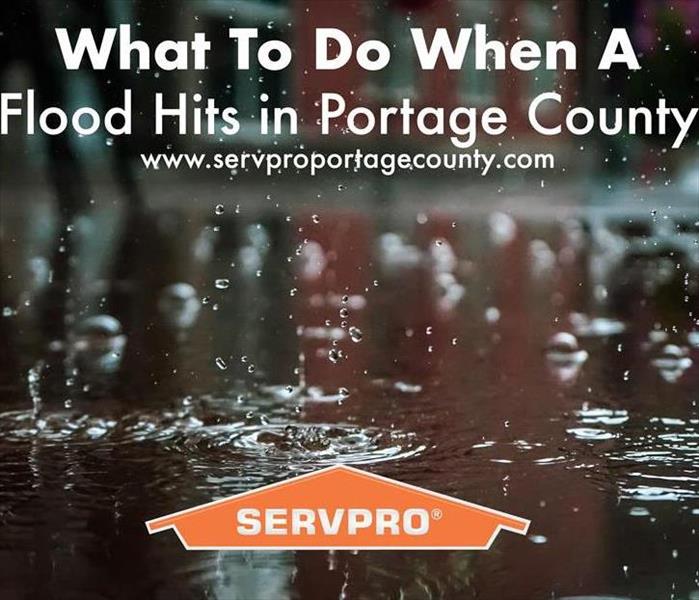 What To Do When A Flood Hits
What To Do When A Flood Hits
Flooding can happen anywhere and is a common natural disaster. The aftermath can cost a pretty penny. Whether floods hit suddenly or more slowly, they can be dangerous and leave a mess in their wake. Don’t underestimate the power of flood waters.
Keep yourself and others safe by following some guidelines of what to do when a flood hits:
- Due Diligence: Check to see if you’re in a flood-prone area. Your local floodplain administrator should be able to help you determine this. Here is a list from the Ohio Dept. of Natural Resources, Division of Soil and Water Resources of the floodplain administrators in Ohio. Installing check valves or having sump pumps installed when necessary will help prevent backing up into sewer traps and homes. Also, ensuring you have comprehensive insurance that covers flood damage is a good idea.
- Proper Preparation: Plan and practice an evacuation route. Having this, disaster supplies, and a communication idea in place will help tremendously in the event of a flood. Be ready to use a radio or TV to stay up to date on the latest information on the storm (status, emergency level, and evacuation readiness). If you have an upstairs and the time to do so, move items of value and possessions you can to higher-ground. Filling the tub, sinks, and vessels with clean water will be beneficial if contamination occurs. Turn off utilities if requested to do so by authorities. Most importantly, never attempt to go through flood waters on foot or vehicle. A split second and two feet is all it takes to be swept away; the waters may be deceiving, as well. Listen closely to the updates and follow any instructions given.
- Aftermath Measures: Depending on the severity of the flood, the county emergency management agency and local government handle everything to meet the immediate needs of the public. The main information you need to remember are merely to be aware of any gas leaks, check the foundation and inspect homes with flood-damage before entering, and any appliances and motors that may have gotten wet should NOT be used until they are appropriately cleaned and dried.
Your state or local emergency management agency can help answer any of your other flood or flood safety questions: the Ohio Department of Natural Resources, Division of Water Resources; the National Weather Service; or your local American Red Cross chapter.
Stay safe, and keep SERVPRO, Portage County, Ohio, (330) 650-4486, in mind for any water damage issues, clean-up, or restoration insurance needs you may have! SERVPRO, “Like it never even happened.”
Backup or Overflow?
2/26/2019 (Permalink)
What is the difference between a water backup and an overflow? Overflow is caused by a blockage in the plumbing system. Water causing damage never enters the sewer system and in some cases, water damage can be considered an overflow if blockage is in the lateral pipe. It all depends on insurance policy language. A backup is a situation where water or sewage enters through drains or sewers or overflows from a sump pump, sump pump well or any other system designed to remove subsurface water which is drained from a foundation area. A water backup is excluded in most Homeowners policies but coverage can be added with an endorsement. Coverage is usually limited to a specified amount but a few insurance companies offer more extensive options. Water backup coverage is critical for not only homeowners but condo owners, renters and commercial insureds as well.
Keep in mind that any property can experience a backup and the damage can be expensive especially if the area is finished. There are four main areas to consider when deciding how much coverage you need including mitigation or drying out the area, structure reconstruction, contents damage and mechanicals such as furnace and water heater. Be sure to discuss the right coverage option with your insurance agent so you are well protected in the event of a backup event.
Sump Pumps
1/30/2019 (Permalink)
Looking at the weather predictions for the week, today is a great day to check your sump pump to verify it is working properly.
When to check your sump pump? How To Test Your Sump Pump?
When to replace it?
When to check it? Sump pumps remove water pressure from homes during times of excessive snowmelt or rainfall. To ensure that your sump pump will work properly when it’s needed, you should check it periodically. It is a habit in my house to check it before, and sometimes during, an extreme weather event.
When to replace it? Did you know that generally sump pump manufacturer warranty their sump pumps for 1 year, 3 year or 5 years. When is the last time you replaced your sump pump? Depending on how much your sump pump runs – you should consider these warranties a good indicator of replacement time. Just because it is still running, doesn’t mean it is functioning at full capacity.
How to test your sump pump? The following tips will help prevent sump pump malfunction:
- Debris in the Basin: Sometimes debris such as children’s toys and other household objects may fall into the basin and interrupt the float mechanism which can cause it to malfunction. The float mechanism can also fail naturally over time. To test this mechanism, fill up the basin with water to make sure the sump pump starts like it should.
- Check Valve: The check valve prevents water from going back into the sump pump in the event of a failure. Make sure to check this valve because it is not always installed properly; the arrow should be pointing away from the sump pump.
- Weep Hole: Sometimes sump pumps may have a weep hole between the pump and the check valve. You can clean the weep hole with a tiny object such as a toothpick, just be careful not to break anything off in the hole.
- Clean the Impeller: The impeller is a small filter that may become clogged and when this happens it can cause the sump pump to suddenly stop running or make a whining noise. Cleaning or replacing the impeller can get the sump pump to function properly again.
- Back Up Power Source: Sump pumps are only useful when plugged into a power source and if the power goes out during a thunderstorm, the sump pump will stop working. Installing a backup power source for the sump pump is the best way to prevent this from happening in the middle of a thunderstorm when the sump pump is needed the most.
Timing is Everything
12/27/2018 (Permalink)
Water damage requires a quick response by stopping the source of water intrusion as soon as possible. Knowing where your water shut off value is located in your residence, and reviewing the location with your immediate family and service professionals (housekeeper, babysitter, dog walker, house sitter, ect) is critical. Prompt response to stopping the water intrusion and clean up and dry out can greatly reduce overall restoration costs. Before water mitigation can begin, the source of the water intrusion will need to be addressed.
Initial steps to assess the damage and evaluate the level of contamination will help to formulate an action plan and determine if professional assistance is needed to help restore your home.
Professional water mitigation should be highly considered when:
- Water originated from a contaminated source: dishwasher, water bed, drain line, toilet, washing machine, flood water, etc. When addressing contaminated materials protecting the home from cross contamination, mold and securing the environment for the occupants becomes a primary focus for the emergency services.
- Porous materials affected by water: hardwood flooring, cabinetry, carpet and padding, drywall, etc. An immediate response to with water extraction and application of a biocide can help reduce the amount of structural material damage and reduce the amount of time the home or affected area is out of use.
- Water traveled from one floor to the floor or floors(s) below. It’s not the obvious water that causes damage, you can easily mop up that. When water and bacteria is trapped between layers of structural materials, this “hidden moisture” can cause long term damage and possible mold growth.
SERVPRO’s professional mitigation team is IICRC Certified, trained, and expertise knowledge to help you evaluate the extent of damage, and create an action plan for cost effective dry out of the affected area(s).
Remember, quick response time can reduce the overall mitigation costs and loss of use. Contact our office to schedule a site inspection and scope of damages for your home today.
How to keep clients’ properties dry in all seasons
11/3/2018 (Permalink)
With water around every corner, clients’ properties are more vulnerable to water damage than many would imagine. In fact, water is the number one property-related homeowners claim, according to Chubb’s claims data, and the Insurance Information Institute found that one in 50 homeowners will experience a related claim each year. When they do, it will cost close to $10,000 per leak.
Despite being both a common and costly risk, a recent Chubb survey of homeowners examining their approach to water damage prevention shows that it’s a threat clients largely overlook. Luckily, agents and brokers can help clients prevent water from damaging their homes, no matter where it comes from. It starts by helping clients understand the seasonal exposures they face.
Ensuring a fun, carefree vacation
Most clients take advantage of the summer to travel with family and friends. Yet too many vacations are ruined as a result of clients failing to take the appropriate water protection steps before departing. Consider that even though many clients ask a caretaker to watch their homes while away, Chubb’s study found that just 30% leave water leak information and only 17% provide information about what to do in the event of a weather-related flood with caretakers.
Why the concern? Time is of the essence when it comes to water damage, with even the smallest leaks or drips building up over time. In fact, the Insurance Institute for Business & Home Safety reports that plumbing supply system failures and toilet failures are the two most common sources of residential water loss. If either of these systems drip for days, the results can be devastating, both in terms of property and financial damage.
Before your clients head out, advise them to:
- Turn off the water supply. This is the only way to prevent a leak from occurring while away; or
- Install a water shut-off device. This is the surest way to prevent wide-spread damage in the event of a leak.
Beyond travel, the warm summer months also provide clients with the opportunity to jumpstart home renovations. But in their desire to drive value, the number one home-related concern identified in Chubb’s study, many clients are inadvertently inviting new water risk into their homes.
Start with encouraging clients to pay close attention to a contractor’s qualifications, prioritizing certifications and licensing above word-of-mouth recommendations. Although both play an important role in the hiring process, Chubb’s study found that 42% of homeowners prioritize the latter, versus 32% who emphasize the former. If contractors don’t have the right experience or professional background, they should not be involved in the client’s renovation project.
Making the most of your time outdoors
Homeowners eager to enjoy the last warm days of the year often spend time working on their gardens, yards and outdoor areas. Many use this time to install sprinkler systems, construct outdoor kitchens and build decks, all designed to enhance their homes’ landscapes. According to Chubb’s survey, close to a third of homeowners (30%) think these types of exterior upgrades most positively impact their homes’ values.
Yet, these projects can quickly let water into all the wrong places. Agents and brokersshould encourage clients to consult with a landscape architect about how enhancements may alter the slope of their garden or clog drains and gutters. Failure to take this into account means new upgrades could redirect water toward clients’ homes, seeping into the foundation or basement over time and potentially resulting in significant damage. By speaking with your clients about their garden renovation projects, this is an expensive loss that agents and brokers can help clients avoid.
Forecasting frozen pipes
Most homeowners know that the pipes in their homes are at risk of bursting during the cold winter months. Homeowners are 40% more likely to have water damage in the winter than any other time of the year, according to Chubb claims data.
Still, only 21% of homeowners report installing pipe insulation, even though it is one of the surest, simplest and cheapest ways to protect exposed pipes in the basement or garage in cold weather. Homeowners might also want to consider hiring a contractor to install pipe insulation for interior pipes that are located adjacent to an outside wall.
Not only does installing pipe insulation help keep the water in a home’s plumbing system from turning to ice and expanding (and thus bursting the pipes), it often helps homeowners save money on their energy bill. In essence, a reminder to install insulation could help clients avoid a major winter headache while also lowering utility bills.
Insurance coverage for drain, sewer and sump pump problems
10/3/2018 (Permalink)
Analysis brought to you by the experts at FC&S Online, the recognized authority on insurance coverage interpretation and analysis for the P&C industry. To find out more — or to have YOUR coverage question answered — visit the National Underwriter website, or contact the editors via Twitter: @FCSbulletins.
Question: This is a Commercial Property risk. I have a toilet that continued to run as the toilet stopper did not seal properly. All would be fine except the heavy rains saturated the drain field not allowing the water to drain from the toilet. This resulted in an overflow causing damage.
The insured has a $10,000 limit on discharge from sewer, drain, or sump from a CP 73 51 endorsement.
Does this limit apply or would it be considered a loss under the normal limits? But for the saturated drain field, there would be no loss. The drain field caused the water to not be able to drain properly; is that a back-up by definition?
— North Carolina Subscriber
Answer: Endorsement CP 73 51 is a proprietary endorsement that includes additional coverage for Discharge From Sewer, Drain Or Sump (Not Flood-Related), up to a $10,000 limit in the endorsement. This response is in regards to the water damage claim submitted for our review. Here are the facts as presented:
- A toilet ran continuously due to a stopper that did not seal properly. The toilet overflowed.
- The drain field overflowed due to heavy rains.
- The drain field is tied to the septic system serving the insured property.
Based on these facts, there are two causes of loss, and we cannot determine the extent of damage from each cause of loss:
- What caused the toilet stopper to not seal properly? Was it wear and tear or faulty workmanship? What interior water damage resulted from the toilet overflow?
- What caused the drain field to overflow? Despite heavy rains, it should still have absorbed the water. So what factors may have contributed to the drain field overflow? Was sludge or other obstruction a contributing factor? What interior water damage resulted from the drain overflow?
This is not an expert opinion, just personal experience with a broken toilet flapper. Regardless of how much the toilet ran, it never ran outside the toilet bowl because the drain carried out the water. If the drain was stopped up, not allowing the water to flow through the drain, then the water could back up and out from the toilet bowl, causing interior water damage.
If the water damage was caused by the broken toilet seal, there would be no coverage.
If the water damage was caused by the drain field overflow, then there would be limited coverage of $10,000 for Discharge From Sewer, Drain Or Sump (Not Flood-Related) provided in the proprietary endorsement CP 73 51.
However, this is an issue of fact, not coverage. We can only speak to the coverages that would be provided in the forms based on the two causes of loss as presented.
Washing machine overflow
Question: Our property coverage contains an exclusion for flood. Included under the flood definition is the exclusion of water or sewage that backs up through sewers, drains or sumps. It also excludes overflow of any body of water.
We have a claim where the fire department put a load of clothes in the washing machine and was called out on a run. During the washing cycle, water overflowed into the building due to the drain being frozen from an ice storm. This was while the firefighters were gone performing their duties. When they returned, the building was flooded, damaging carpet and sheet-rock. Is this covered?
— Oklahoma Subscriber
Answer: We do not see an exclusion that would apply in this situation. It doesn’t sound as if the water actually went down a drain and then backed up. The washing machine overflowed because water could not go down the frozen drain, which would not constitute a backup. So, in our opinion, the loss is covered.
Sump pump and water backup
Question: One of the more common claims we handle deals with sump pumps and applicable exclusions. In this case, the business owner’s policy contains the following provision, “We will pay for loss or damage to covered property caused by water that backs up from a sewer or drain, subject to the following limitations: We will not pay for loss or damage under this Additional Coverage caused by the emanation of water from a sewer or drain that itself is caused by, or is the result of “flood,” surface water, waves, tides, tidal waves, overflow of any body of water or their spray, all whether driven by wind or not;”.
Carrier issued a denial, as follows:
In view of the cited exclusions, the water damage to the basement is the result of flood and groundwater; therefore, we would not make a payment for this loss.
The loss was not caused by flood or surface water, but a high water table that overwhelmed the pump’s capability to function due to two major rain events one year ago. When the water table receded, the pump functioned so it was not failure in the sense one thinks of failure, i.e., mechanical or electrical. Water entered through the sump, through some cracks in the floor.
My belief is that this is a covered loss. I could not find any information on the definition of “sump pump,” the purpose of a sump pump, or the definition of “groundwater.”
The carrier used the term “groundwater” in the denial. That is not addressed in the endorsement.
— Connecticut Subscriber
Answer: It does not sound like the water backed up through the sump pump but in fact came through the cracks in the floor.
This type of loss would be subject to the part of the water exclusion that states, “Water under the ground surface pressing on, or flowing through… floors… basements.” (This can be seen in the ISO BP 00 03 01 10, B.1.g.) If the insured has purchased sewer and drain backup coverage, it would not apply to this type of loss. However, if it can be shown that the water really did overflow or was discharged from the sump (as opposed to seeping in through floor cracks), that would be covered.
The ‘whys’ behind lack of flood insurance coverage
10/3/2018 (Permalink)
One of the ongoing issues with hurricanes and other flood disasters is the fact that many, many people lack flood insurance. But why is that? Why are people not buying the coverage they need?
The Private Risk Management Association (PRMA) conducted a survey of agents about why their insureds do or do not carry flood insurance. We had the chance to talk to Lisa Lindsay of PRMA about the study and its results.
Their study showed that across the board, whether high net worth or not, people’s mindset is that “It won’t happen to me.” Flood insurance is seen as something homeowners are required to have, not something they need to protect their assets. The study showed that many people only buy flood insurance because the bank says they have to. They later celebrate when they’re no longer required to hold flood insurance because their mortgage has been paid off.
Likewise, consumers have been conditioned to believe that unless they are in a high-hazard flood zone, coverage is not needed. The fact that flooding occurs in many non-high hazard areas is overlooked. It’s not just coastal areas that flood, but areas near rivers, streams and even low-lying areas in towns where runoff can accumulate often flood, causing unsuspecting homeowners damage that’s not covered by their normal homeowners’ policy.
Better understanding of mitigation efforts
Not only do people need a better understanding of flood insurance, but they also need a better understanding of mitigation efforts, that is, steps they can take to prevent or minimize flooding and reduce the potential damage. Sandbags, inflatable barriers and landscaping are just some ways people can prepare for a flood. Both the National Flood Insurance Program (NFIP) policy and the new ISO Personal Flood Policy provide up to $1,000 for steps taken to protect the insured building from flood or imminent danger of flood. The $1,000 is provided for the cost of:
- Sandbags and sand to fill them,
- Fill for temporary levees,
- Pumps,
- Plastic sheeting, and
- Lumber used in connection with these items.
As most insureds don’t read their policies, it’s likely that most are unaware of these coverage benefits for mitigation of damages.
Private flood policies to the rescue?
With the concern surrounding the National Flood Insurance Program (NFIP), carriers are beginning to issue private flood policies. For example, one carrier has a private flood policy with limits up to $15 million on property, much higher than the NFIP limits of $250,000.
ISO has developed both a Commercial Flood program and a Personal Flood program, both available this year. The expansion of available coverage should be a tremendous help in getting homeowners insured. However, education of agents and the public is key.
Better analytics is helping to make private coverage possible; instead of just referring to the standard flood maps, which may be out of date, there are companies providing better analysis of property that includes rainfall, local topography, elevation and susceptibility to hurricanes, not just for rains but for winds and storm surge as well.
Although flood insurance can be expensive in some places, in many areas that’s not the case. As a result, property owners don’t investigate their options for coverage.
Another issue is construction itself. Builders resist changes to codes to make properties safer while continuing to want to rebuild in areas that have been flooded. If building is going to occur in such areas, the buildings need to be built in a way to protect the property as much as possible from flooding. People also get a false sense of security from the fact that the town has allowed buildings to be constructed in low-lying areas, figuring that if zoning approved of the area it must be safe to construct a home in that area.
Understanding the 100-year flood
Yet another large issue is the misperception of the 100-year flood. Many people believe that this means that the chance of their property being flooded is one in 100 years. What it really means is that every year there is a 1% chance of flood. This puts the property at significant risk, as not only do 100-year storms need to be accounted for, but other storms as well.
Time Period10 Yr.25 Yr.50 Yr.100 YrTotal Odds1 yr.10%4%2%1%17%10 yr.65%34%18%10%127%20 yr.88%56%33%18%195%30 yr.96%71%45%26%238%50 yr.99%87%64%39%289%
Source: FC&S Online
The overarching issue is how to educate both the public and the industry on flood mitigation techniques and the availability of insurance coverage. The industry needs to inform people of not only what their risk is but also about the available risk evaluation tools, mitigation techniques and available coverage. Agents and brokers need to be well informed in order to proactively change the narrative of flooding and coverage.
This website requires certain cookies to work and uses other cookies to help you have the best experience. By visiting this website, certain cookies h
9/9/2018 (Permalink)
Coping with repairs or replacement of equipment and furnishings seriously damaged by water filtration or flooding is challenging enough for owners and managers of commercial businesses and offices.
Coping with repairs or replacement of equipment and furnishings seriously damaged by water filtration or flooding is challenging enough for owners and managers of commercial businesses and offices. Yet, many overlook one of the greatest consequences – the potentially irreparable damage to documents.
Whether the documents are paper, books, files, medical records, electronic media or legal documents, any delay in the decision to dry the materials can result in permanent loss. Inks can break down, making the text illegible. Dirt and grime can penetrate the paper and pages can adhere. Mold and mildew will grow quickly on water-soaked documents.
That’s why the key to a successful recovery of these materials is rapid response time. And, this response should be handled by a document restoration specialist.
An experienced provider will rapidly identify the best recovery method for a particular material, based on the value of the documents and the level of damage. For example, in the right circumstances, freezing documents can drastically reduce the time and cost of restoration. It also prevents the need for mold remediation, page separation and other, more expensive, corrective procedures.
Consider partnering with a provider that can assist in the clean-up of the disaster area and stabilize the indoor environment to reduce the moisture load to prevent the spoiling of unaffected documents.
Following are the key phases of a document restoration project and the steps involved for a successful recovery.
The Recovery Process
The recovery process requires the technical expertise and equipment of a proven service provider. It’s important that this restoration company is up-to-date with the most advanced techniques available, such as vacuum freeze drying, blast freezing, microbial disinfecting, deodorization, soot removal, and more.
The recovery process to dry and clean documents begins with two initial steps:
- Freezing. In order to halt deterioration, it is essential that documents be frozen as soon as possible. Usually, freezer-equipped truck trailers or freezer warehouses are used for this stage. The frozen materials can be stored until the professional drying procedure begins.
- Inventory and Sorting. While the documents are frozen, decisions can be made regarding which to dry and clean and which to discard; work can begin to prune unwanted materials. Loose documents and files stored in cabinets are packed into boxes, labeled to identify contents.
The Drying Procedure
The second phase is the drying of the materials. Depending upon the type and extent of damage, and the materials, different treatments may be recommended. There are two primary methods used to dry documents – vacuum freeze-drying and desiccant drying.
Vacuum Freeze-Drying
A freeze drying process is the most efficient and effective method for the drying of wet papers and other documents. Using accelerated vacuum freeze dry systems, Polygon technicians can restore water-damaged materials quickly and effectively, reducing back processing time by 20 to 30 percent compared to similar systems.
During this process, the materials are placed in an airtight chamber into which negative vacuum pressure is induced. As a function of physics, moisture in the documents turns into a gaseous state. The “gas” is expelled from the chamber, where it is condensed into liquid, which is then aborted. As a result, the documents go from the frozen state to being dry without ever becoming re-liquefied.
This method is especially beneficial in cases where documents may warp or distort. After drying, materials will have a smoother appearance than is generally achieved via slower, less efficient freeze drying methods.
Desiccant Drying
In this process, the frozen documents are removed from the packing cases and placed on racks and shelves in a large, vault-like 6,000 square-foot room. Applying desiccant dehumidification, the room atmosphere is maintained at about 68ºF and 12% humidity.
Desiccants attract moisture molecules directly from the air and release them into an exhaust air stream. Desiccants can attract and hold from 10 to more than 10,000 percent of their dry weight in water vapor. The essential characteristic of desiccants is low surface vapor pressure. A cool, dry desiccant can attract moisture from the air because its surface vapor pressure is low. When the desiccant becomes wet and hot, creating high surface vapor pressure, it will give off vapor to the surrounding air. Vapor moves from the air to the desiccant and back again depending on the vapor pressure differences.
Desiccant dehumidifiers use the changing vapor pressures to dry air continuously in a repeating cycle. In so doing, the continually moving dry air created in the drying room removes the moisture from the documents. Depending on the amount of moisture and documents being dried, the process can take from one to seven days to complete.
Cleaning
After drying, the documents are cleaned and then placed into new boxes, re-labeled according to the inventory and returned to the owner.
Cleaning removes any dirt or grime and, more importantly, fungi spores. Trained staff clean each document using materials such as sponges and scrub pads, while avoiding the application of liquid solutions that would reactivate the moisture in the materials. In cases when they deal with mold spores, individuals wear personal protection equipment and follow standard procedures for spore removal, including the use of High Efficiency Particulate Arrestor (HEPA) vacuum systems.
Cleaning also is accomplished on non-paper materials that are not first dried, such as film, microfiche, x-rays and audio and videotape.
All of this work requires the provider to offer properly trained cleaning and restoration technicians and management staff oversee your recovery projects. Some providers will use temporary labor while others utilize seasoned professionals that typically have five to 10 years experience.
Offering the necessary technology also is important. A qualified document center should offer blast freezing, which freezes quickly and kills bacteria; stabilization or capacity to freeze documents to mitigate damage; cleaning; desiccant air drying; vacuum freeze drying; and secure document storage.
On-Site Drying Option
In some cases, disaster-affected entities require that documents be dried at the site. Confidential files, information needed on a regular basis or legal requirements all may dictate that situation. In such cases, an on-site drying facility is established.
In this case, standing water is removed and damaged documents packed and placed in a nearby freezer warehouse or refrigerated trailers. The goal is to use the fastest methods to make critical documents usable and to save as many others as possible.
A provider may establish a processing center nearby in a rented building a short distance from the freezer warehouse. This space must be prepared by sealing air leaks and creating a climate controlled environment via portable industrial desiccant dehumidifiers.
This processing center will include a thawing room, where frozen documents are identified, categorized, labeled and logged into a computerized inventory control system. It also should include a second area where moisture is removed from the documents in a drying chamber.
At the same time, non-paper items, including x-rays and computer disks, which are not suitable to the freeze-drying process, are salvaged through desiccant drying.
Preparation is Key
The best insurance against catastrophic loss of vital documents is to be prepared in advance of a disaster. Having a written Disaster Recovery Plan (DRP) can limit the extent of damage by defining and prioritizing the recovery steps. Including a document recovery section in the overall DRP will detail essential steps and include contact sources for recovery.
Water Damage Requires a Quick Response
9/4/2018 (Permalink)
Floods, rainstorms and tornadoes can become massive water damage threats to businesses during the often-stormy spring and summer months. Facilities plagued with such water woes this season must take quick action
Floods, rainstorms and tornadoes can become massive water damage threats to businesses during the often-stormy spring and summer months. Facilities plagued with such water woes this season must take quick action to control many possible problems, experts say.
You won’t see it emphasized on the nightly news when a disaster hits, but water damage can represent potentially huge disasters for businesses and building owners and operators.
Water damage can mean much more to a business than just wet and soggy carpets. There are other common, more significant problems businesses face when water wreaks havoc on property, such as indoor air quality problems. Mold and mildew grow rapidly in damp, humid environments, leaving behind an unpleasant smell that permeates floors, walls and ceilings, even after the water has been removed. It also can create health problems for employees.
Damage to the building’s structure and foundation also can be an issue. When water sits inside a building for a period of time, the walls, ceilings and floors absorb the water, which threatens the overall structural integrity of the building and creates an unsafe environment. Total reconstruction of the building often becomes the only option.
Another major threat to business is the loss of expensive equipment, which often can cost hundreds of thousands of dollars to replace.
To minimize water damage, there are two critical steps that need to be taken:
- Act fast to assess the situation; and
- Control the environment within the building.
Act Fast and Call an Expert
The absolute first step to take is fast action. Damage resulting from water and flooding is very progressive. The longer the water flows or wet conditions are allowed to exist, the greater the recovery problem becomes. A water damage consultant must come in immediately to survey the situation.
In a typical scenario, a team of water damage recovery professionals is dispatched to the site to perform a thorough inspection and fully determine the extent of the damage. A disaster reclamation partner also will develop an intense restoration plan and determine which items are worth restoring and which are better replaced.
You can’t always save everything by drying, but you can save a tremendous amount. It’s not unusual to save between 30 and 70 percent of the cost needed to reconstruct a facility.
Controlling the Interior Environment
Another key in limiting water damage is to quickly control three conditions of a building’s atmosphere: relative humidity, temperature and air circulation. Fast, effective action at this point will generally confine the damage to the area that was directly affected by the water damage event.
The most effective way to control these conditions in a high-moisture environment, especially a large facility, is to employ professional disaster drying that combines air movers with desiccant dehumidifiers.
Disaster drying often eliminates the need to rip out and replace walls, carpet, floor covering, hardwood floors and the building structure, which can be a huge expense. On top of that, you preclude the odors and staining caused by mold and mildew. These problems can come back to haunt you weeks later in a superficially dried building.
The Desiccant Way
When a facility has been severely water damaged, you need high volume desiccant dehumidifiers. Some larger desiccant dehumidifiers can pull 800 gallons of water out of a building in one day, compared to the typical small refrigeration units that remove about five gallons a day.
Many people are surprised that “solid” materials such as concrete and hard woods absorb moisture. But they do and rather quickly.
Getting the water back involves a phenomenon called migration. Migration is the tendency for water molecules to move toward a low vapor pressure. When a room is filled with very dry air, which has low vapor pressure, trapped water migrates outward and is evaporated from the surface by the dry air. As the air in the room fills with water vapor, we expel it. We then replace it with more dry air and the process continues.
It’s also essential to be sure the equipment being used is sized right. Inappropriately sized drying equipment can lead to insufficient drying and long-term problems with the building. Only large-volume dehumidifiers could provide the massive drying power needed to dry the space quickly and thoroughly.
Best Defense: A Disaster Recovery Plan
To minimize damage and costs, companies need to think ahead about what to do in a water damage event and contact a water damage expert to create a Disaster Recovery Plan (DRP).
A DRP can limit the extent of water damage occurrences by defining and prioritizing the recovery of areas within a facility and stating immediate next steps. Proper planning and fast action are most certainly the best defense to preventing a catastrophic water damage event.
Flooding Rains and Toxic Spills, Beware, Ohio
2/26/2018 (Permalink)
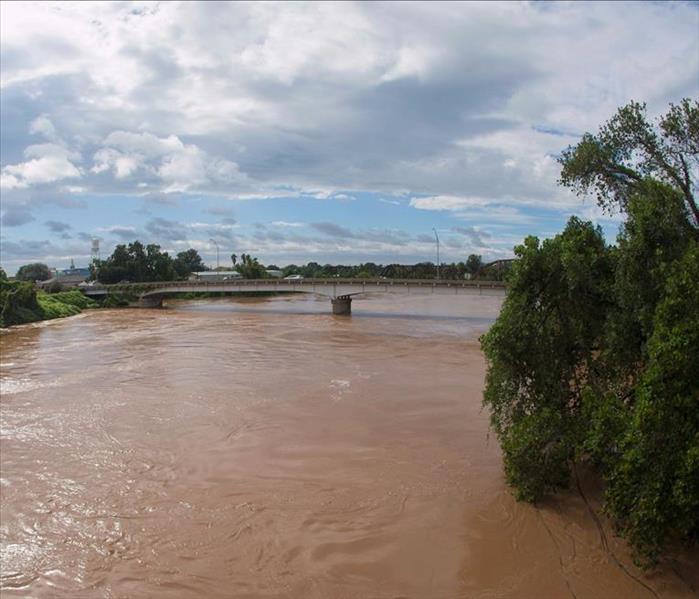 With floods becoming more frequent, the risk of toxic spills has increased too, experts warn.
With floods becoming more frequent, the risk of toxic spills has increased too, experts warn.
"A report by The New York Times found that of the more than 21,600 facilities across the country that handle large quantities of toxic materials, over 1,400 are in areas the Federal Emergency Management Agency considers to have a high risk of flooding.
The proximity of these chemical sites to areas prone to flooding is a relic from a time when industrial operations benefited from being close to rivers and oceans – the bodies of water allowed for transportation, trade, or even a ready supply of cooling water.
Experts believe that this outdated business practice could lead to a major environmental and health disaster." Excerpt from: Insurance Business Magazine
Reported by the Cleveland Patch in their Feb. 8, 2018 article, Toxic Waste Being Reduced In Cuyahoga, Across Ohio, while Cleveland is one of the top five states with the most toxic releases, reports from the Environmental Protection Agency (EPA) show less toxic waste is being released. Also reported, Ohio is seeing a new low in toxic waste being disposed.
"There was 102 million pounds of toxic waste disposed of in the Buckeye State in 2016, the lowest total since at least 2003," the author, Chris Mosby, writes.
"Cuyahoga County had about 7 million pounds of waste to dispose of in 2016. More than 47 million pounds of waste was either disposed of, recycled, treated, used for energy recovery or source reduction."
The EPA said the majority of compounds released in our country falls into the "other" category. The largest identified compound being zinc, the Centers for Disease Control and Prevention's Agency for Toxic Substances and Disease Registry reports very little is known about the long-term effects of exposure to zinc.
As Cleveland and surrounding counties are prone to Lake Erie's floods and lake-effect weather, we must continue the movements Ohio is making to improve our toxic waste disposals.
Sources: https://patch.com/ohio/cleveland/toxic-waste-being-reduced-cuyahoga-across-ohio
https://www.insurancebusinessmag.com/us/news/environmental/experts-as-floods-worsen-so-does-the-risk-of-toxic-spills-91979.aspx
Rain Gutters and Water Problems
2/2/2018 (Permalink)
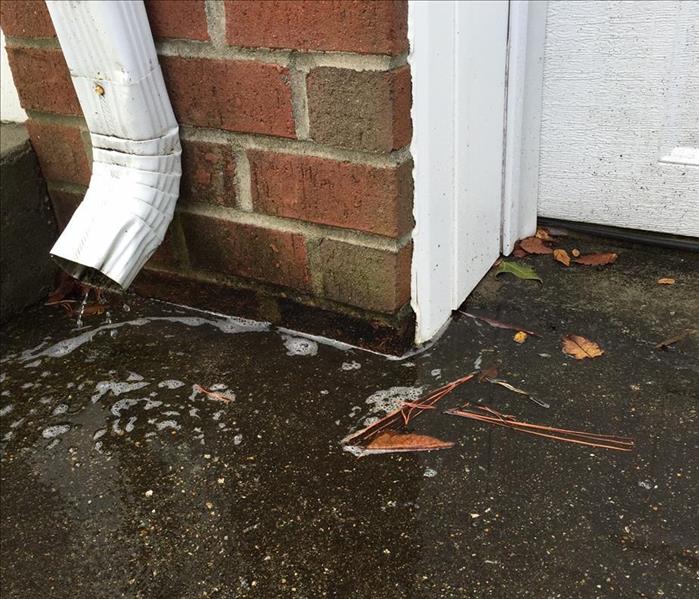 The financial costs of poor drainage can be substantial, and the human health costs significant too.
The financial costs of poor drainage can be substantial, and the human health costs significant too.
Most homes have gutter downspouts that lead straight to the ground, which means all the water from the roof is pouring to just one point where it can collect against a home's foundation. This most often causes the water drainage problems and, thus, the damage.
Prevention is important. Here are some clues that you may have a problem with your gutters:
- Areas where the ground is wet for long periods of time after it rains or the sprinklers are running signal an area where the water is collecting
- Discoloration and mold growth on a home's foundation and siding or paint is easily falling off your house are indications that water is pooling.
- Musty smells in your basement or crawlspace signal water may be getting into your home.
Financial costs of poor water drainage can add up, but the good news is that gutter problems are an easy fix.
Do you have water damage in your home or business ? Call SERVPRO of Portage County's 24/7 Emergency Service line at 330-677-4483 or request help online at our franchise website.
Frozen and Burst Pipes- Understand and Take Precaution
12/27/2017 (Permalink)
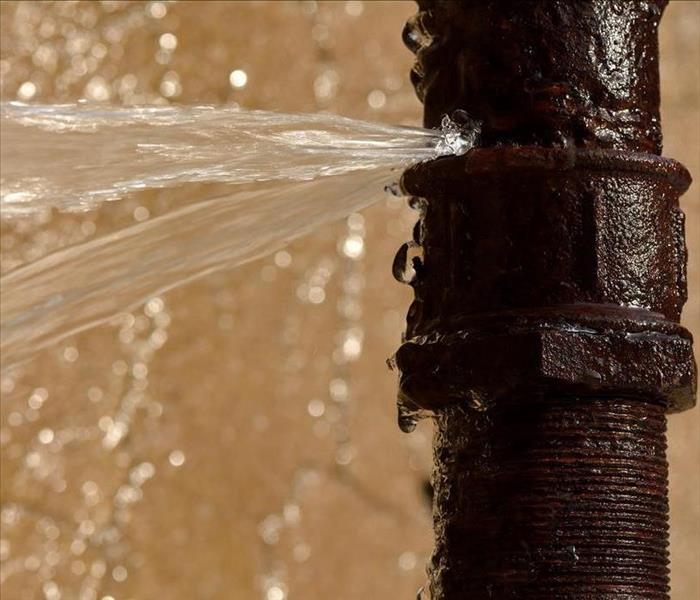 "Even a small crack in a burst pipe can spew hundreds or even thousands of gallons of water in a day."
"Even a small crack in a burst pipe can spew hundreds or even thousands of gallons of water in a day."
If your pipes are exposed to temperatures below 32 degrees Fahrenheit for an extended period of time, the water can freeze and cause extensive damage to your home. This can be avoided!
Frozen pipes can occur for two basic reasons:
- Installation of pipes in an unheated space without adequate protection
- Insufficient heat in the area of the freeze
What types of pipes are susceptible this situation? Domestic water piping, HVAC heating and cooling piping and sprinkler piping are all vulnerable if left in cold and unprotected conditions as stated above. Plastic and metal pipes can burst when they freeze, and depending on the size of the pipe, even a small crack in a burst pipe can spew hundreds or even thousands of gallons of water in a day.
Why does a pipe burst, anyway? Well, when water freezes, it expands. The ice expansion will exert pressure against the pipe wall but also pressurizes the water trapped between the ice and a closed valve or fixture. As the water continues to freeze and expand inside the pipe, it causes the trapped water to continue to increase in pressure, thus, just as a can of soda will burst in your freezer, so does your water pipe.
Some common locations where pipes will freeze are outdoor hose bibs, swimming pool supply lines, fire sprinkler lines and water supply pipes in unheated interior areas. These areas include basements, crawlspaces, attics, garages, bathroom sink cabinets and kitchen cabinets. Pipes along exterior walls that have little or no insulation, voids in the insulation or improperly installed building wrap are subject to freezing. You might want to check in on that sooner rather than later. Review the International Plumbing Code by clicking here.
On what you, the homeowner, can do to prevent a pipe burst from happening, refer back to our blog piece, "How to Thaw a Frozen Pipe."
Remember, this stressful situation can be avoided if you think ahead!
With any questions or if your home has been water-damaged, call SERVPRO of Portage County on our 24/7 Emergency Service line, 330-677-4483 or Request Help Online.
How to Thaw a Frozen Pipe
11/14/2017 (Permalink)
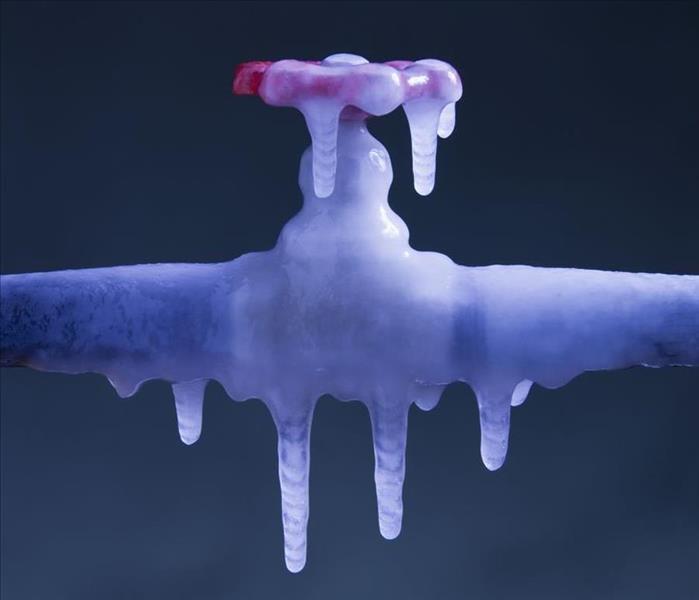 A frozen pipe exerts pressure at over 2,000 Lbs/ square inch, enough pressure to rupture almost any pipe filled with water.
A frozen pipe exerts pressure at over 2,000 Lbs/ square inch, enough pressure to rupture almost any pipe filled with water.
Frozen water pipes are a serious risk during very cold winter weather. When water freezes in a pipe it expands and can exert pressure at over 2,000 pounds per square inch. This pressure is enough to rupture almost any pipe filled with water, which provides no place for the ice to expand. A burst pipe can spill several hundred gallons of water per hour, and that equates to thousands of dollars of damage to your home. Pipes are most susceptible to freezing when they are located:
- in an outside wall
- in a cabinet under a sink (especially near an outside wall)
- in an unheated crawl space or basement
If your pipe is frozen but not yet ruptured, you must thaw it right away. There are a few thawing techniques to try, depending on where the frozen pipe is located.
Warning: Never use a blow torch or other open flame to thaw a pipe. This presents a serious fire hazard and can damage the pipe.
A frozen pipe that hasn't burst yet often reveals itself at a faucet: when you turn on the faucet and no water comes out or it has slowed to a trickle, there's probably a blockage of ice somewhere in the line. It's time take immediate action:
- Shut off the water to the faucet locally or at the home's main water shutoff valve.
- Open the faucet that is supplied by the frozen pipe; do this even if you don't know where the blockage is.
- Identify the frozen pipe and locate the blockage: Follow the pipe back from the faucet to where it runs through cold areas, such as an exterior wall or unheated crawl space. Look for areas on the pipe that have frost or ice; it may also be slightly bulged or fissured.
When you find that the frozen—but not yet burst—pipe is behind a wall or ceiling, you've got a challenge on your hands. You have three options for thawing the pipe:
- Turn up the heat in the house and wait.
- Cut out a section of the wall or ceiling to access the frozen section of pipe, then thaw the pipe as an exposed pipe (see next slide).
- Use an infrared lamp to help heat the wall section in front of where you believe the pipe is frozen. Infrared lamps are better than regular heat lamps because they pass through the air without heating it and will direct more energy to warming the wall and frozen pipe.
If the frozen pipe is exposed, you have several options for thawing it. Whichever remedy use use, heat the pipe from the faucet toward the frozen area. This allows water to flow out as the ice melts.
- Hair dryer: Usually the easiest and safest way to thaw a pipe. If the pipe is close to the wall, place a cookie sheet behind the pipe to help radiate heat onto the backside of the pipe.
- Heat lamp: You can use an infrared or incandescent heat lamp. As with a hair dryer, if the pipe is close to the wall, use a cookie sheet behind the pipe to help reflect heat onto the pipe.
- Portable heater: A small, powerful heater works great for warming pipes under a kitchen or vanity base cabinet. Direct the heater onto the frozen section of pipe. It will work like a hair dryer on steroids!
- Electric pipe heat tape: Heat tape is a ribbon-like wrap that contains electrical heating elements. You wrap it around the pipe you want to heat and plug it into the wall. The temperature of the tape is controlled with a thermostat. Heat tape can also be used to prevent pipes from freezing in critical areas; you can leave the heat tape on the pipe and plug it in only when needed.
There are a few things you can do to prevent the problem of freezing pipes from occurring again:
- Leave the faucet dripping slightly during the coldest time of the day or night.
- Open the cabinet doors to allow the heated air from the room to reach pipes inside the cabinet.
- Wrap the problem pipe with electrical heat tape.
- Insulate problem pipes with foam insulation wrap, especially those that run through unheated spaces. Note: Insulation merely slows the transfer of heat and will not prevent a pipe from freezing if the surrounding air is cold enough.
- Heat unheated areas with a permanent heater, just to keep the temperature above freezing, or about 40 degrees F. Warning: Do not use portable heaters, which should never be left running unattended.
- Remove garden hoses attached to outdoor faucets (hose bibs or sill cocks). If the faucet is not a frost-proof type, turn off the water to the faucet inside the house and drain the exterior section of the pipe and faucet.
Preparing Your Home for Winter Weather- Avoiding Water Damage
10/31/2017 (Permalink)
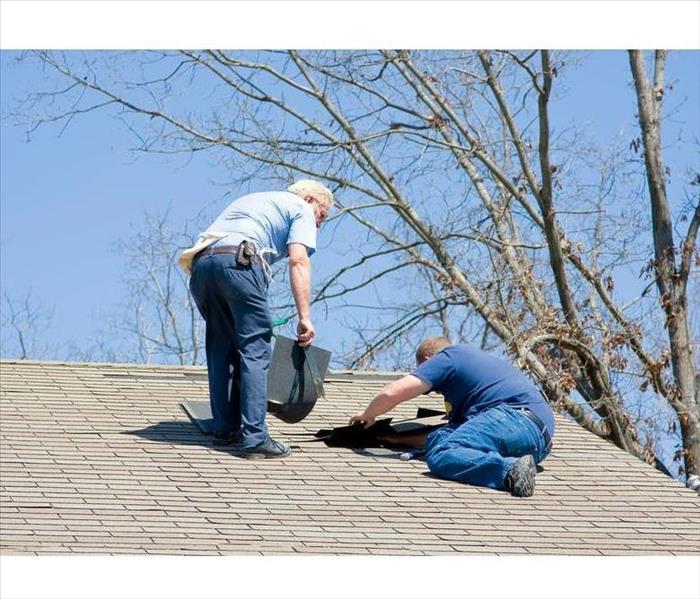 Inspect your roof and gutters on a regular basis — at least twice a year.
Inspect your roof and gutters on a regular basis — at least twice a year.
With winter on the way, we’re heading into a busy time of year that includes several major holidays coming back-to-back. The last thing we want to worry about is the risk of water damage due to the changing weather.
Here are some wintertime considerations to keep your home safe and reduce, or even prevent, possible insurance risks:
- Keep your drains and gutters clean. Exactly how frequently depends on where you live, but you want to plan for twice a year. Clogged gutters can cause a few issues including roof leaks. If your gutters can't drain properly, the excess water can soak through the shingles and eventually start leaking into your home. Don't forget melting snow can also fill up the gutters, causing similar issues!
- Inspect your roof for damage and leaks. While you're cleaning those gutters, take the time to inspect your roof. Keep an eye our for cracks, leaks where different parts of the roof meet, and general wear and tear. You should do this also twice a year at least.
- Water expands, its mass increasing by about 9% when it freezes. Blocked pipes result in a buildup of pressure, which can cause a burst pipe, equipment malfunction, or contaminated water back-up inside the building. To avoid this, consider insulating your water lines and using heat tape as well.
- For extreme weather, it is wise to always leave a tap running at a trickle because running water is less likely to freeze.
Watch for our next blog post on how to defrost a frozen water pipe.
The Truth About 100-Year Floods
10/17/2017 (Permalink)
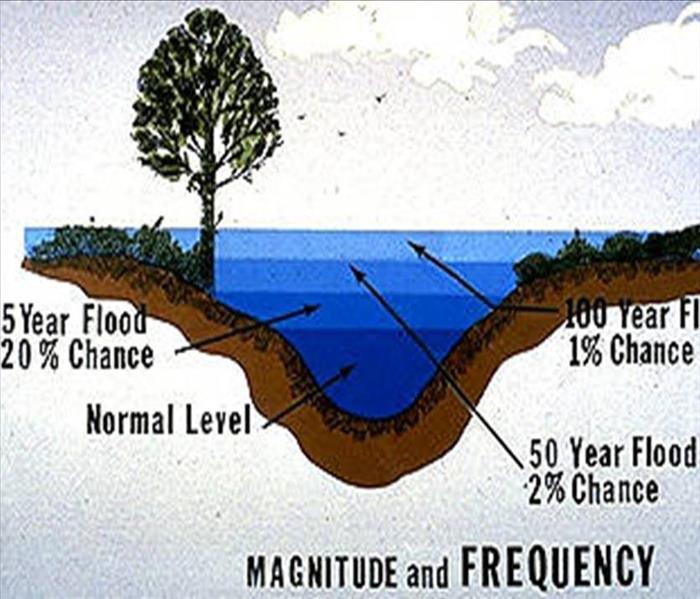 The above image includes a diagram demonstrating the magnitude and frequency of water levels during a flood.
The above image includes a diagram demonstrating the magnitude and frequency of water levels during a flood.
Whenever a strong hurricane or storm causes significant flooding, there is often talk of a 100-year flood. People will think a flood of that magnitude occurs once every hundred years, so they should be safe from harm for the next hundred years. Some base their decision to buy flood insurance on this false belief, putting them at risk of a catastrophic loss.
In order to determine the true frequency of floods, scientists will create a history of the area, tracking the frequency of different sized floods and the average number of years between them to develop the probability of a given sized flood in a particular year.
But rain volume alone does not always create the flood. The condition of the ground before the rain is critically important. If the area has received a lot of rain recently and the ground is already saturated, less rain is needed to flood the area. If the area has been experiencing a drought and the rain is falling fast, it is possible for the water to run off instead of soaking into the ground.
Factors such as a river basin and the addition of dams and levees will be considered. Once a flood recedes, high-water marks will be surveyed by scientists to estimate the maximum flows and streamgages will record the height and quantity of flow.
Explained by Property Casualty 360 in their article "The truth about 100-year floods," "The accumulation of data allows for a determination of the annual probability that a given stream or river will exceed its banks. This is known as annual exceedance probability, or AEP. A 1% AEP flood has a 1 in 100 chance of occurring every year, with an average recurrence every 100 years. This is the 100-year flood." They also predict during a span of a 30-year mortgage, "there is a 26% chance of a home in a 1% AEP, or 100-year flood area, of being flooded."
Questions about flood damage? Call SERVPRO of Portage County today at- 330-677-4483.
Faster to Your Portage County Water Damage
9/6/2017 (Permalink)
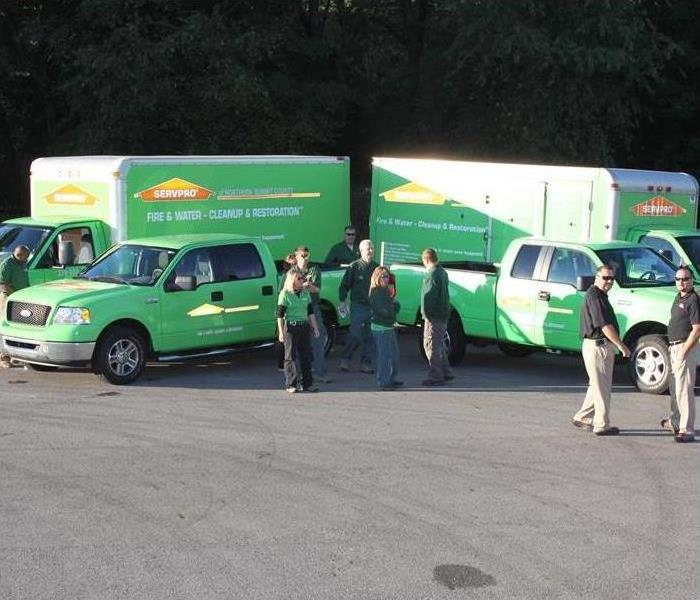 SERVPRO of Portage County provides 24 hour fire and water damage restoration service in Kent, Ravenna, Streetsboro and surrounding areas.
SERVPRO of Portage County provides 24 hour fire and water damage restoration service in Kent, Ravenna, Streetsboro and surrounding areas.
Flooding and water emergencies don’t wait for regular business hours and neither do we. SERVPRO of Portage County, OH provides emergency cleaning and restoration services 24 hours a day, 7 days a week—including all holidays.
Faster To Any Size Disaster
Flooding and water damage is very invasive. Water quickly spreads throughout your home and gets absorbed into floors, walls, furniture, and more. SERVPRO of Portage County arrives quickly and starts the water extraction process almost immediately. This immediate response helps to minimize the damage and the cleaning and restoration costs.
Need Emergency Service? Call Us 24/7 – 330-677-4483
Water Damage Timeline
Within Minutes
- Water quickly spreads throughout your property, saturating everything in its path.
- Water is absorbed into walls, floors, upholstery, and belongings.
- Furniture finishes may bleed, causing permanent staining on carpets.
- Photographs, books, and other paper goods start to swell and warp.
Hours 1 - 24:
- Drywall begins to swell and break down.
- Metal surfaces begin to tarnish.
- Furniture begins to swell and crack.
- Dyes and inks from cloth and paper goods spread and stain.
- A musty odor appears.
48 Hours to 1 Week:
- Mold and mildew may grow and spread.
- Doors, windows, and studs swell and warp.
- Metal begins to rust and corrode.
- Furniture warps and shows signs of mold.
- Paint begins to blister.
- Wood flooring swells and warps.
- Serious biohazard contamination is possible.
More Than 1 Week:
- Restoration time and cost increase dramatically; replacing contaminated materials and structural rebuilding may be extensive.
- Structural safety, mold growth, and biohazard contaminants pose serious risks to occupants.
About SERVPRO of Portage County
SERVPRO of Portage County, OH specializes in the cleanup and restoration of residential and commercial property after a fire, smoke or water damage event. Our staff is highly trained in property damage restoration. From initial and ongoing training at SERVPRO’s corporate training facility to regular IICRC-industry certification, rest assured our staff is equipped with the knowledge to restore your property
The Basics of Sewer Backup Insurance
9/6/2017 (Permalink)
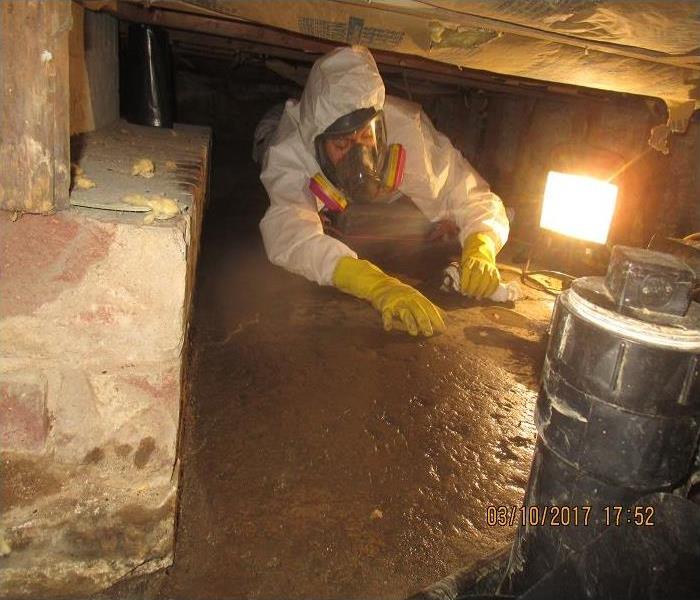 Our Professionals are trained to regular IICRC industry certifications, Employee Certification Training, Initial Franchise Training & Continuing Edu.
Our Professionals are trained to regular IICRC industry certifications, Employee Certification Training, Initial Franchise Training & Continuing Edu.
While shopping for home insurance, it's important to anticipate all the headaches that can go along with home-ownership, including sewer backup.
When sewage flows into your home, it can cause thousands of dollars in damage, and typical home insurance and flood insurance policies won't cover those expenses.
If your sewer's system's pipeline combines storm water and sewage, it's more likely to become overloaded during harsh weather. Tree roots can enter your pipes and cause blockages, or improperly disposing of cooking grease or flushing inappropriate objects down the toilet (diapers, feminine hygiene products or paper towels).
Many homeowners may not realize they are responsible for the maintenance and repair of the pipeline between the city sewer main, usually located in the street, and their house.
Sewage backup coverage is available from most insurers as a rider to a home insurance policy. Coverage for $5,000 to $10,000 in damages can run about $75 to $150 a year, according to FEMA, and there's usually a deductible.
If sewage seeps into your home, not only does the spill itself need to be addressed, but your plumbing may need to be flushed or replaced. Duct-work carpets, drapes and walls may be soiled, possibly beyond repair. Ewser backup insurance helps pay for incidental damage, such as cleaning contents, walls and furniture and some policies may cover work on plumbing.
To get the maximum claims payment to which you're entitled, make sure you have photos on hand of what your home looked like before the damage took place. That way, you can provide your claims adjuster with "before" and "after" pictures. Be sure to itemize property losses and save all receipts for repairs and cleaning.
Do you have water damage in your home?
For help restoring your home after a water loss, call our 24/7 Emergency Service team at 330-677-4486
6 Ways to Protect Your Home From Flooding
9/1/2017 (Permalink)
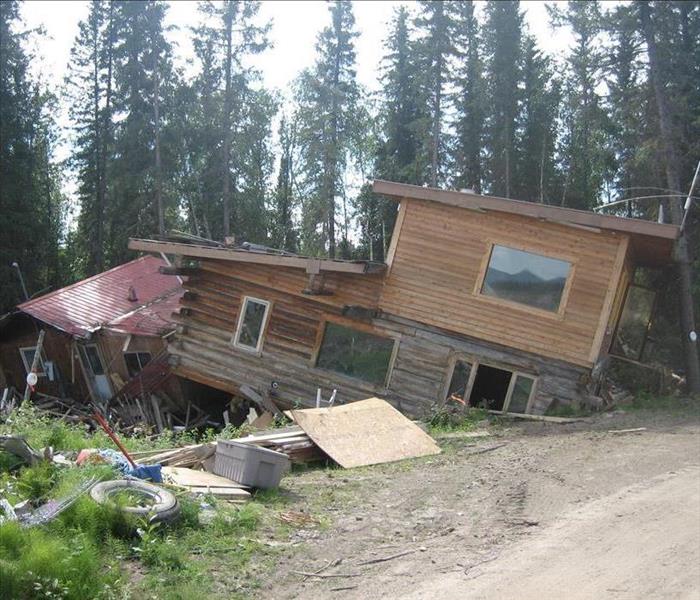 The erosive force of moving water can drag dirt from under a building's foundation, causing it to crack and tumble.
The erosive force of moving water can drag dirt from under a building's foundation, causing it to crack and tumble.
Flooding can strike anywhere and at any time, and floods are the most common and most expensive natural disaster in the U.S. Ignoring the risk means a destroyed home and belongings, and mold soon follows that.
Your first step in avoiding this risk is knowing the flood level of the home you're buying- an official measure of how high floodwaters could rise. You can find this information at FEMA's online flood maps.
Your next steps in protecting your home from flooding should include these 6 measures:
- Safeguard in-home electrical and climate systems. Raise switches, sockets, circuit breakers and wiring at least a foot above the expected flood level in your area. Modify your furnace, water heater, and any other anchored indoor equipment.
- Anchor and raise outdoor equipment. Fuel tanks, air-conditioning units and generators should be anchored above your flood level. Unanchored fuel tanks can break free, and severed supply lines will contaminate surrounding ground.
- Modify water valves. A flooded sewer system can cause sewage to back up in your home. Install an interior or exterior backflow valve.
- Determine how water flows around your house. The grading or slope of the house, the angle of the ground, can direct water to or away from your house. This is easy to determine by watching how water flows or accumulates during an average rainstorm.
- Opt for a major retrofit. If your home floods frequently and moving isn't an option, you may need to take drastic and costly measures. Either raise your home on piers or columns so the lowest floor is above flood level, wet-proof your home by installing foundation vents that would allow water to flow through the building instead of rising inside, or do some dry-proofing by applying coatings and other sealing materials to your walls to keep our floods.
- Take last-minute measures as waters rise. Clear gutters, drains and downspouts. Move furniture, rugs, electronics and other belongings to upper floors. Shut off electricity at the breaker panel. Elevate major appliances onto concrete blocks if they're in harm's way.
If you have any flood damage in your home or building, call SERVPRO of Canton today at our 24/7 Emergency Service Line - (330) 966-2377 or at our Online Help Line.
Water Back-Up, Overflow or Discharge? Homeowners' Claims
8/22/2017 (Permalink)
Last month we talked about how to protect your home from flood damage. Hopefully the tips served you well, but here are some tips on what causes a water back-up or overflow and whether or not there is coverage for such a loss.
Is it a water back-up, an overflow or discharge?
A back-up is a build-up caused by a stoppage in the flow. Something prevents the water from continuing down its path, so it is forced to reverse direction and go back the other way.
- Causes: A collapsed drain pipe can cause a back-up because water can no longer proceed down its normal course. A blockage can also cause a back-up. The blockage prevents the water from going forward. Both of these factors force the water to reverse direction.
An overflow is when excess or surplus is not able to be accommodated by an available space.
- Causes: The space is filled to capacity and water then spreads beyond its limits. A bath tub left running creates an overflow, as well.
Discharge is what happens when water is released from plumbing or appliances and then floods your home.
- A leaking pipe discharges water from the hole in the pipe.
The ISO HO 00 03 provides coverage for water damage that is the result of a discharge or overflow of a plumbing, heating, air conditioning, or household appliance if it is on the resident’s premises. This covers:
- Pipes that leak behind walls
- Floors, or ceilings
- Washing machines and dishwashers that overflow
- Toilets that overflow
- Storm drains off premises that overflow due to high rains or floods
It is important to note that a sump, sump pump or related equipment, or a roof drain, gutter or downspout or similar equipment is not considered a plumbing system or household appliance.
A discharge or overflow caused by a storm drain, water, steam, or sewer pipe is covered as well if it is off the premises.
Frozen Pipe Bursts Part 3: What to do if a Frozen Pipe Bursts
2/2/2016 (Permalink)
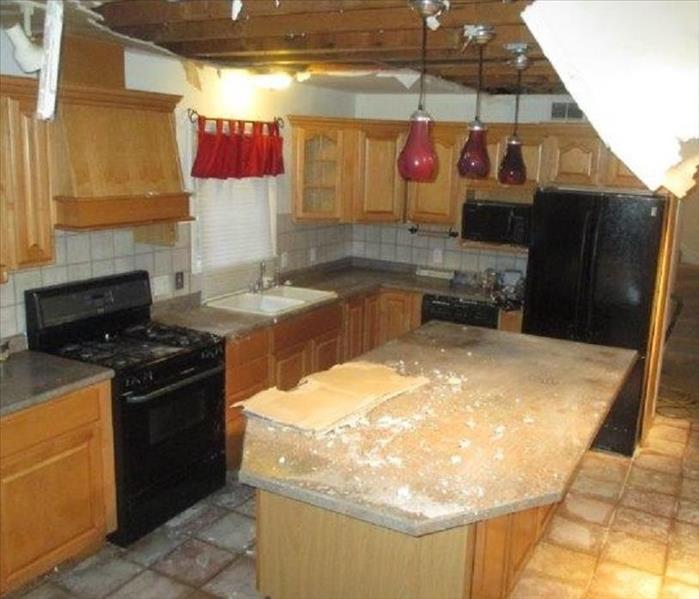 Damage resulting from a pipe burst due to a frozen pipe
Damage resulting from a pipe burst due to a frozen pipe
Taking preventative measures and noticing frozen pipes in time to thaw blockages are key to avoiding pipe bursts. Unfortunately, sometimes disasters occur despite our best efforts at prevention. In the unfortunate event that a frozen pipe does burst, you can mitigate the damage by following these important tips:
- Turn off the main water supply immediately.
- If the water is flowing near any electrical outlets or conductors of electricity, you should also shut off the electricity.
- Contact a plumber to repair the burst pipe.
- Remove the water. Use buckets, towels, and a wet/dry vacuum to remove water from the affected area.
- Act quickly! The longer there are wet materials in your home, the greater chance there is for mold, warping, and more serious damage.
- If you feel that the water damage is too much for you to handle on your own or you would like assistance in the cleanup, contact the qualified water mitigation specialists at SERVPRO to assist you.
If you or someone you know is faced with a pipe burst, the experts at SERVPRO can help to mitigate the damage and restore your home!
Sources:
http://www.policyexpert.co.uk/insurance-blog/house-home/pipes-burst-freeze/
https://www.washingtonpost.com/local/what-to-do-if-a-frozen-pipe-bursts-in-your-home/2015/02/19/af9b87be-b857-11e4-aa05-1ce812b3fdd2_story.html
Frozen Pipe Bursts Part 2: Thawing Frozen Pipes
1/5/2016 (Permalink)
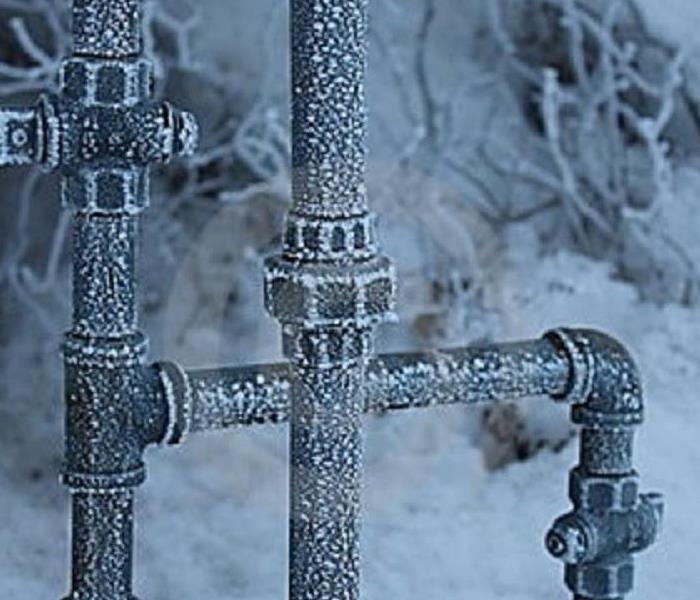 Act quickly if you discover frozen pipes in your home to avoid damage due to pipe bursts.
Act quickly if you discover frozen pipes in your home to avoid damage due to pipe bursts.
Frozen Pipe Bursts Part 2: Thawing Frozen Pipes
In the previous blog post, we discussed how to prevent frozen pipes in order to avoid a pipe burst. If a frozen pipe occurs despite your best efforts at prevention, there are still steps that you can take to thaw the affected pipe before a burst occurs and the situation becomes a much bigger issue. You will notice a pipe may have frozen when after turning on a tap no water or a very small trickle comes out.
- The first thing you should do is turn off the main water supply. If you don’t already know where your main water supply is, locate it now in order to be able to act quickly if you ever find yourself in a situation where your pipes have frozen.
- Locate the frozen pipe by turning on taps one at a time to see if water flows out. If water flows in all areas of the house except for one, trace the line from the blocked faucet to areas that may be more exposed to cold. If water does not flow out of any of the taps, the frozen pipe may be located near the water meter.
- Once you have located the affected area, use a blow dryer, heat lamp, or other heat source to apply heat to the affected area. Do NOT use a blowtorch or any other device with an open flame.
- Keep the faucet open and apply heat from the open tap toward the blockage. Continue to apply heat until the water flows from the faucet at normal pressure.
- If you are struggling to find the blockage or are unsure if the pipe is clearing properly, contact a plumber.
Even during a close call with a frozen pipe, if you follow these steps and put the preventative tips from the previous blog post into action, you can boost your chances of avoiding water damage to your home due to a pipe burst.
Sources:
http://www.oldhouseweb.com/how-to-advice/thawing-frozen-pipes.shtml
http://www.redcross.org/prepare/disaster/winter-storm/preventing-thawing-frozen-pipes
Frozen Pipe Bursts Part 1: Preventing Frozen Pipes during Winter Months
12/16/2015 (Permalink)
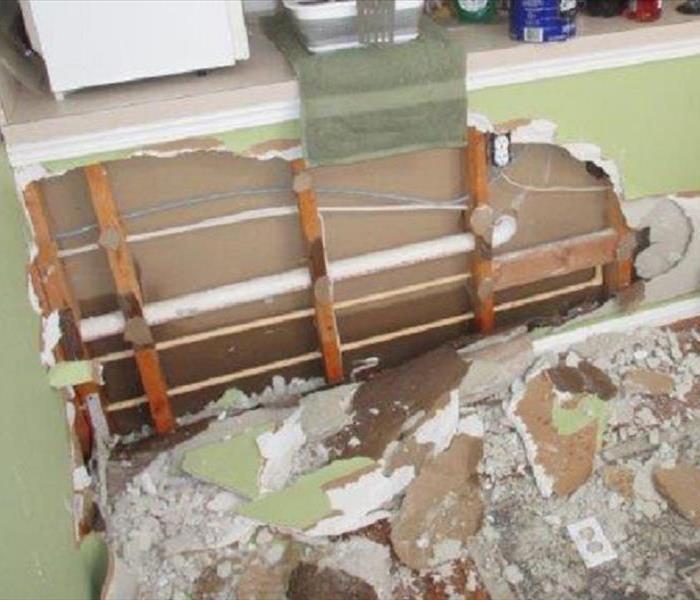 Damage that occurred as a result of a pipe burst due to a frozen pipe.
Damage that occurred as a result of a pipe burst due to a frozen pipe.
Frozen pipes can mean big problems for your home. As water freezes, it expands and can exert up to 2,000 pounds of pressure per square inch! That pressure can cause pipes to burst and water to flow into your home, potentially causing extensive damage.
Taking preventative measures during the cold winter months is the best course of action to avoid frozen pipe bursts. The pipes that are most susceptible to freezing are those that are outdoors, are exposed to exterior walls, or are in unheated areas like under cabinets or in attics or crawl spaces. In order to prevent frozen pipes in those areas, follow these tips:
- Drain water from hoses, water sprinklers, and other outdoor lines when the weather starts to cool down and they will no longer be in use.
- On particularly cold days, open cabinet doors to allow warm air to flow around pipes and turn on the taps slightly to allow a slow drip to run through the faucets.
- Make sure that there is insulation present in areas around pipes that are more susceptible to cold weather.
- Consider installing heating cable, heating tape, newspaper, or another form of insulation around exposed pipes.
- If you are leaving for vacation, don’t set the temperature any lower than 55°F.
Putting these tips into practice will significantly reduce your chances of having a pipe freeze in your home, and thereby, avoid the larger and much more costly and inconvenient problem of a pipe burst.
Sources:
http://homerepair.about.com/od/plumbingrepair/ss/thaw_frzn_pipe.htm#step1
http://www.redcross.org/prepare/disaster/winter-storm/preventing-thawing-frozen-pipes
Do's and Don'ts to follow after a Flood or other Water Loss
9/8/2014 (Permalink)
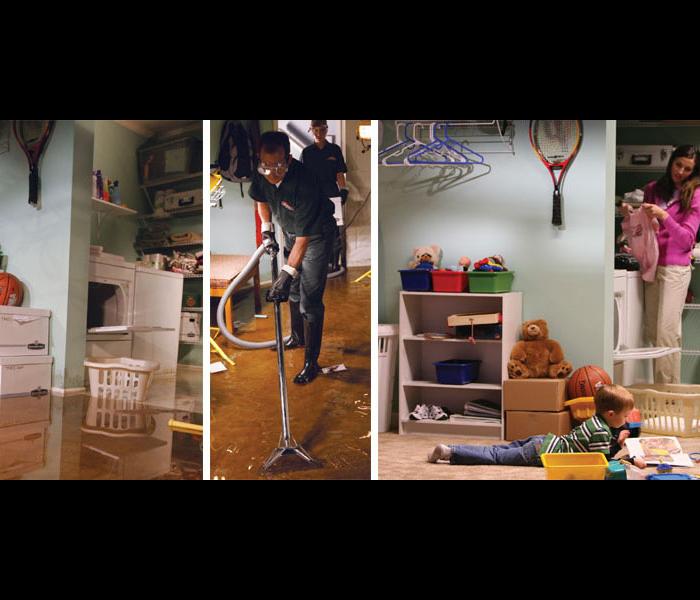 By following these steps before water mitigation begins, you can take great steps to avoid further property damage in your wet basement or other area
By following these steps before water mitigation begins, you can take great steps to avoid further property damage in your wet basement or other area
The period after a large storm or flood is often a hectic and confusing time. While waiting for SERVPRO to arrive to perform water damage or flood cleanup, here are some simple do’s and don’ts to follow until help arrives. By following these steps before water mitigation begins, you can take great steps to avoid further property damage in your wet basement or other areas of your home:
For CLEAN Water Losses
DO
1. Shut off the source of water if possible or contact a qualified party to stop the water source.
2. Turn off circuit breakers for wet areas of the building when access to the power distribution panel is safe from electrical shock.
3. Remove as much excess water as possible by mopping and blotting.
4. Wipe excess water from wood furniture after removing lamps and tabletop items.
5. Remove ad prop up wet upholstery cushions for even drying.
6. Place aluminum foil or wood blocks between furniture legs and wet carpeting.
7. Remove to a safe, dry place any paintings, art objects, computers, documents and other materials that are valuable or sensitive to moisture.
8. Use wooden clothespins to keep furniture skirting off damp floors.
9. Hang draperies with coated hangers to avoid contact with wet carpeting or floors.
10. Hang furs and leather goods to dry separately at room temperature.
DON’T
1. Enter rooms with standing water where electrical hazards may exist.
2. Enter affected areas if electrical outlets, switches, circuit breakers or electrical equipment are exposed to water. Always avoid electrical shock hazards.
3. Leave books, newspapers, magazines or other colored items on wet carpets or floors to cause staining.
4. Leave Oriental rugs or other colored rugs on wet wall-to-wall carpets to cause staining.
5. Use your household vacuum cleaner to remove water, possibly causing electrical shock or damage to the vacuum cleaner.
6. Use TV’s or other appliances while standing on wet carpets or floors, especially not on wet concrete floors.
7. Turn on ceiling fixtures if ceiling is wet or enter rooms where ceilings are sagging from retained water.
Additional Information for CONTAMINATED Water Losses
DO
1. Avoid all contact with sewage and items contaminated by sewage.
2. Wash your hands thoroughly after contact with contaminated items.
DON’T
1. Spread contaminated water by walking unnecessarily on damaged or wet areas.
2. Turn on the HVAC system is there is a possibility of spreading contaminated air.
3. Use household fans to dry the structure and spread contaminants.
4. Use products for personal hygiene and cleanliness if exposed to the contaminated area.






 24/7 Emergency Service
24/7 Emergency Service

